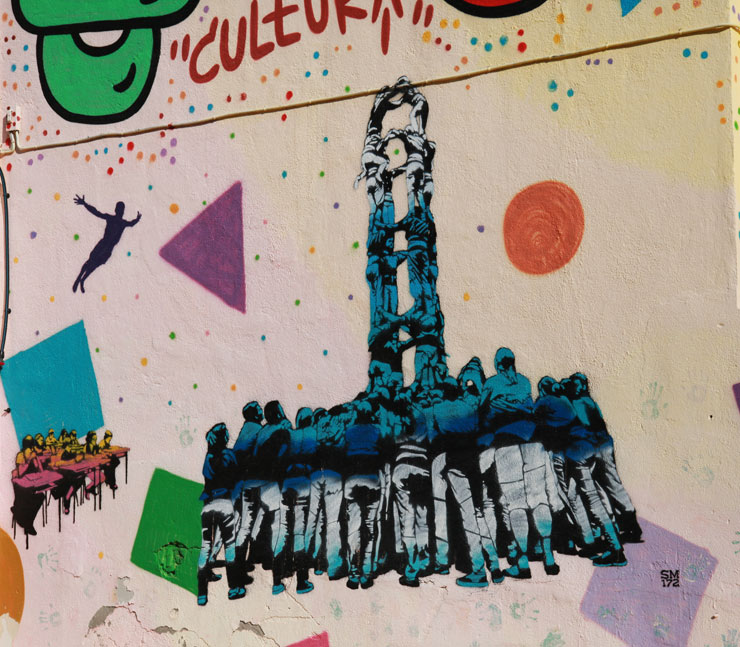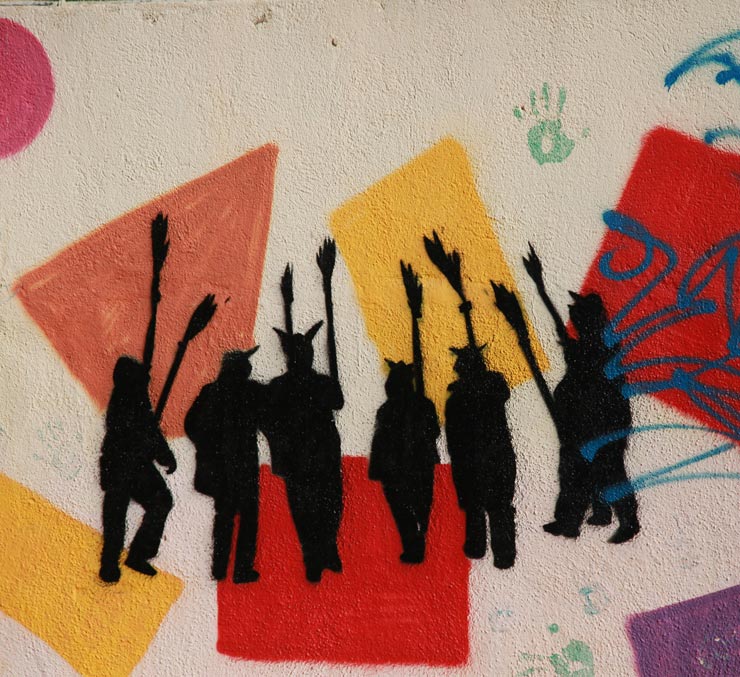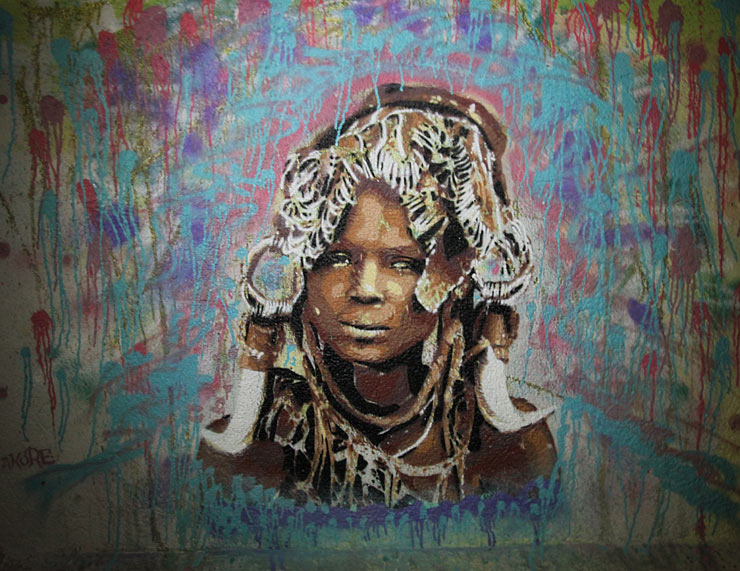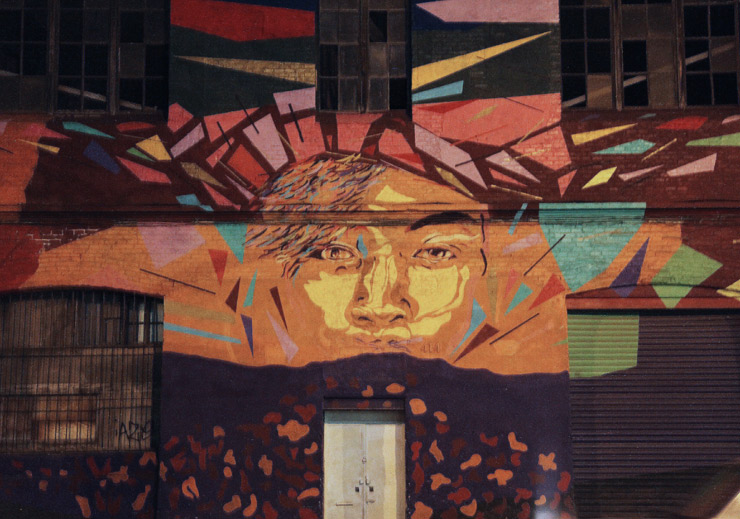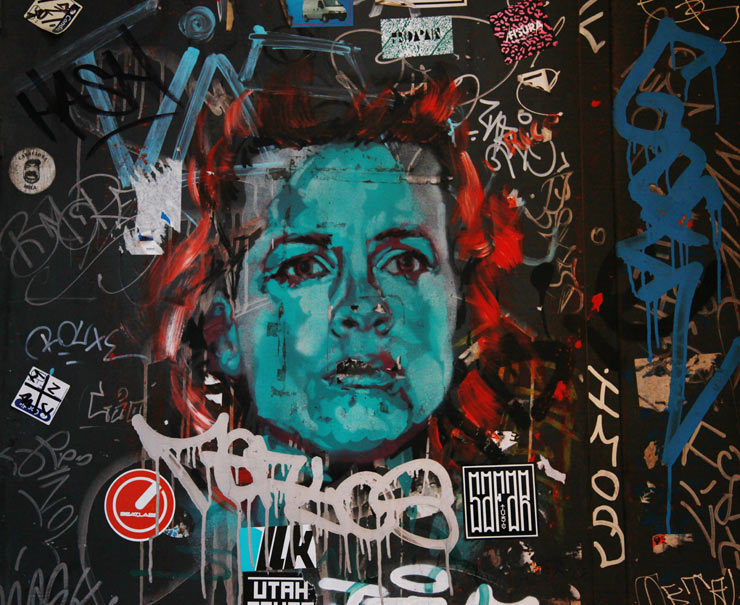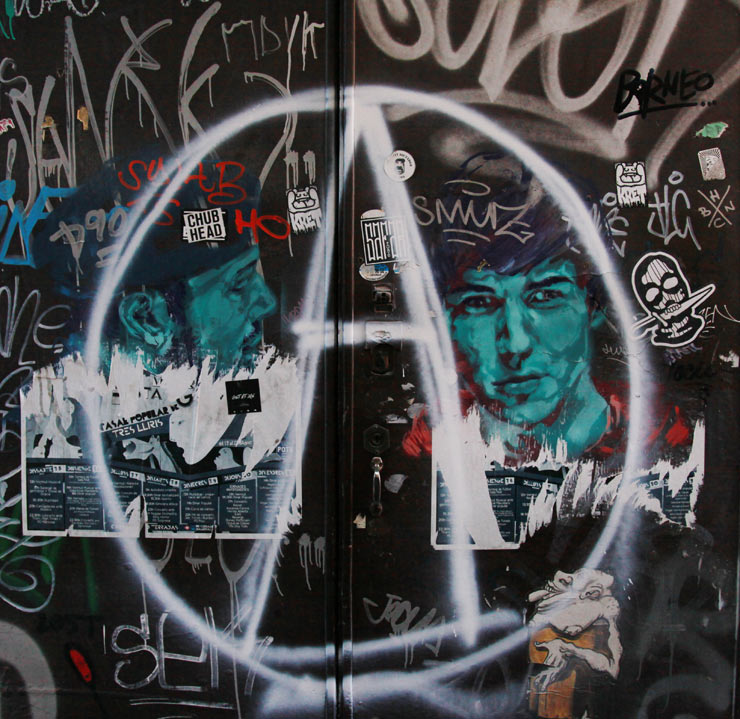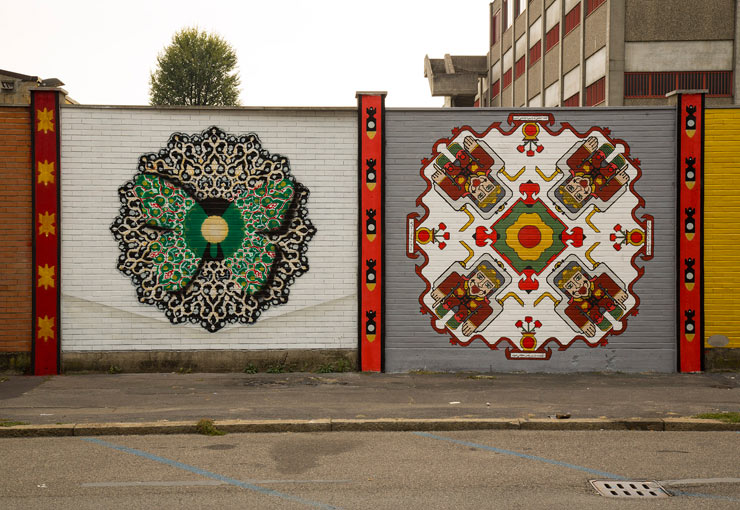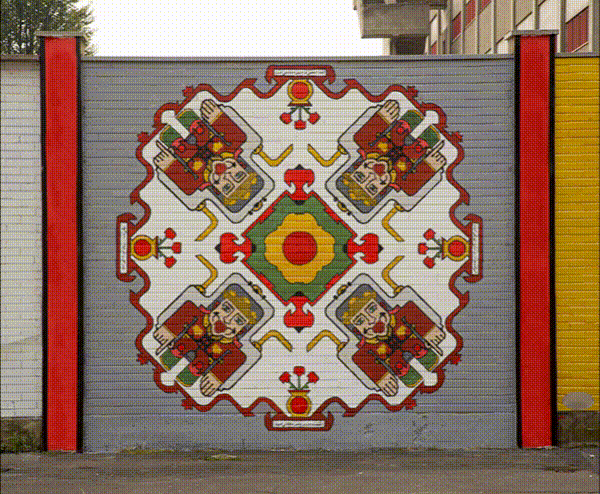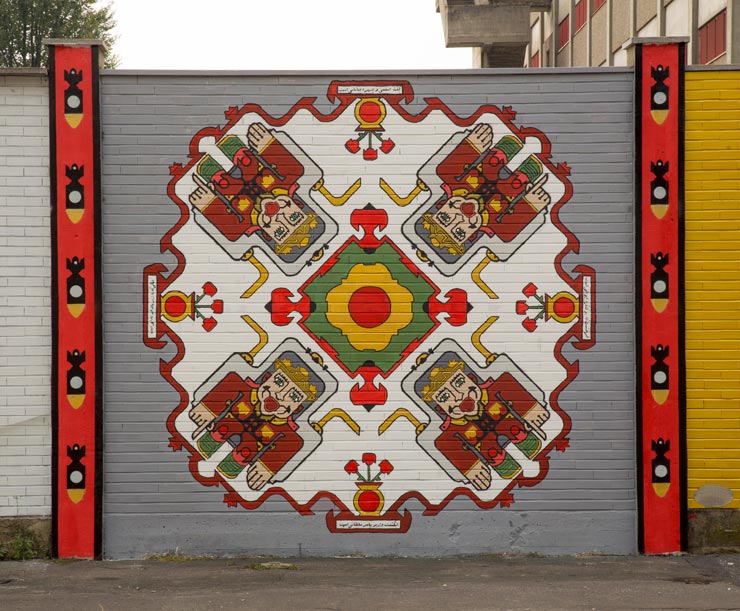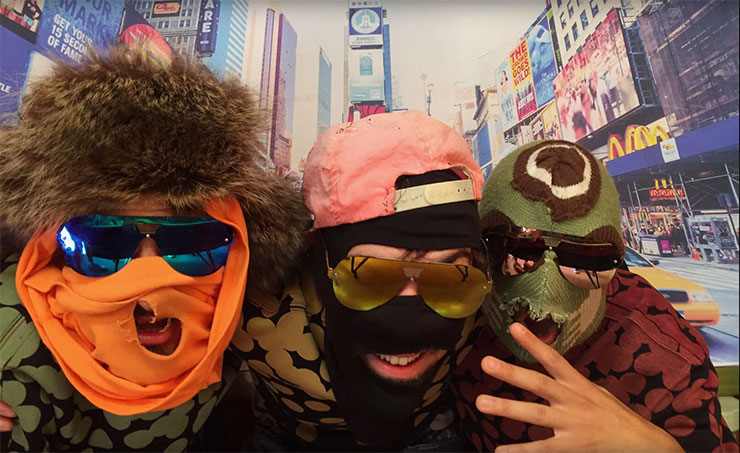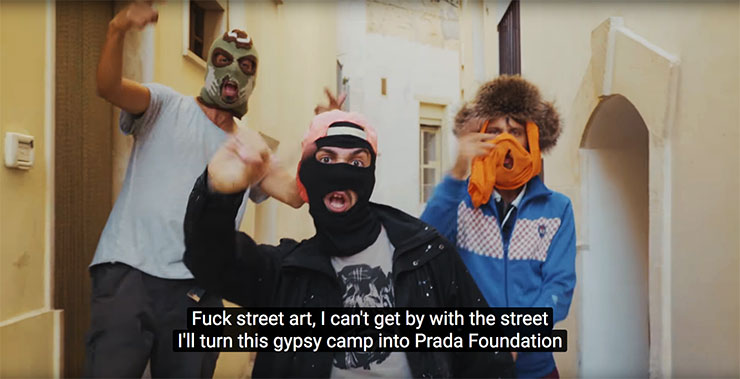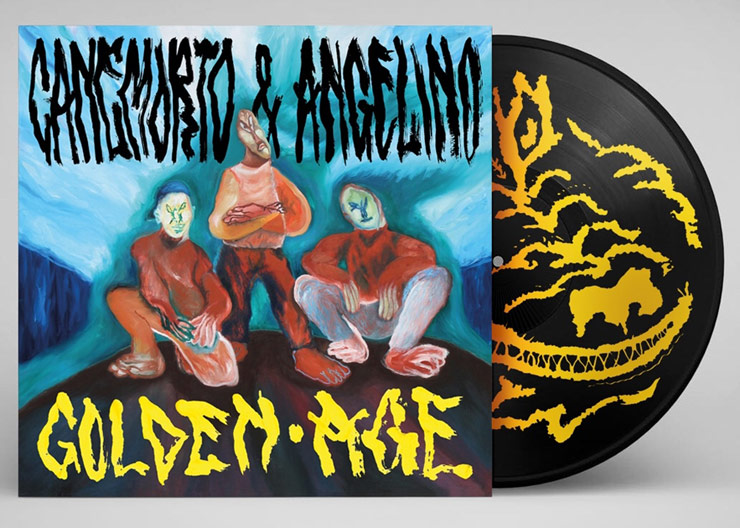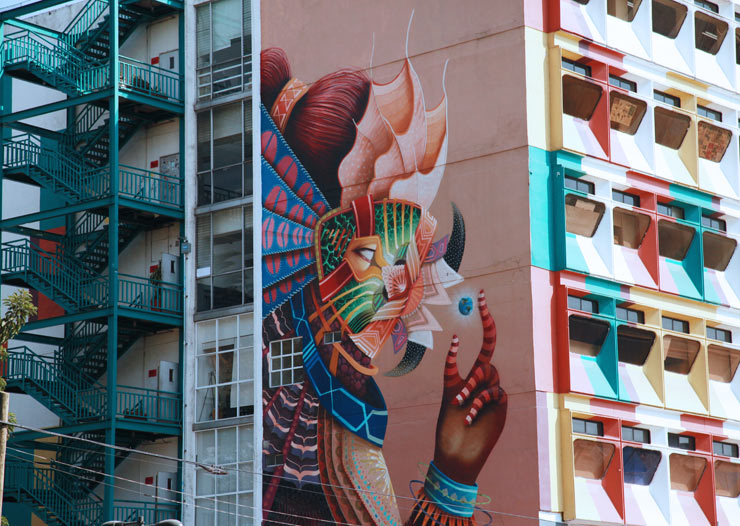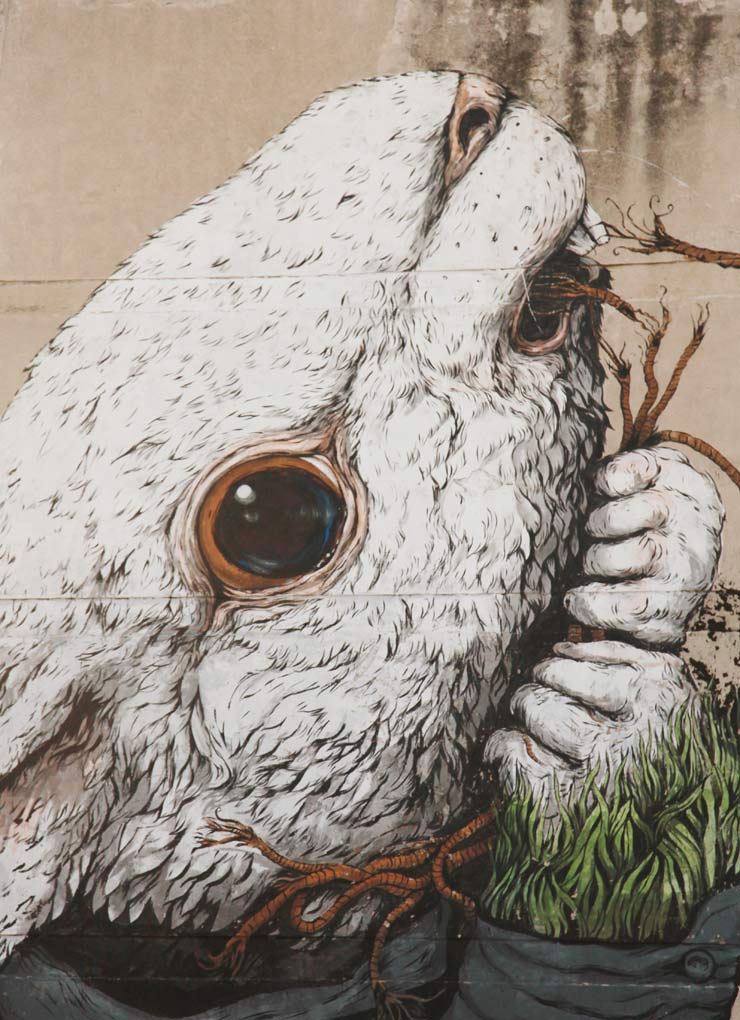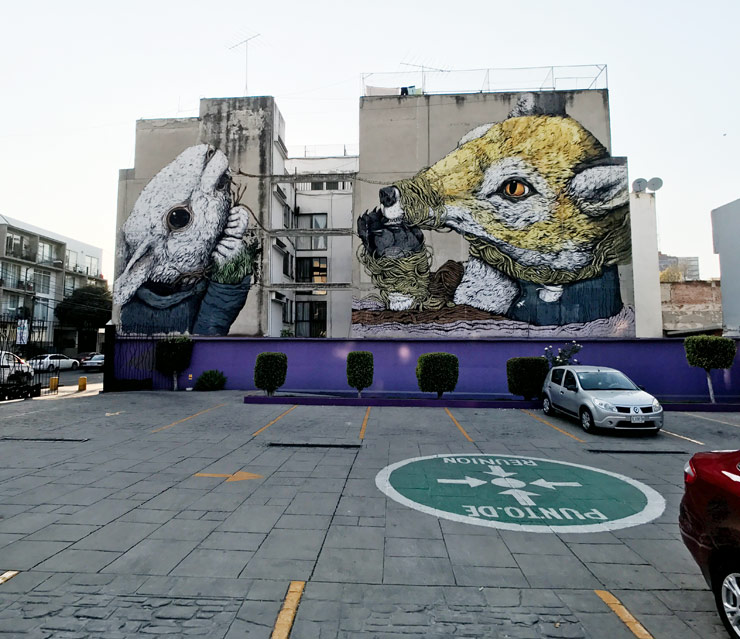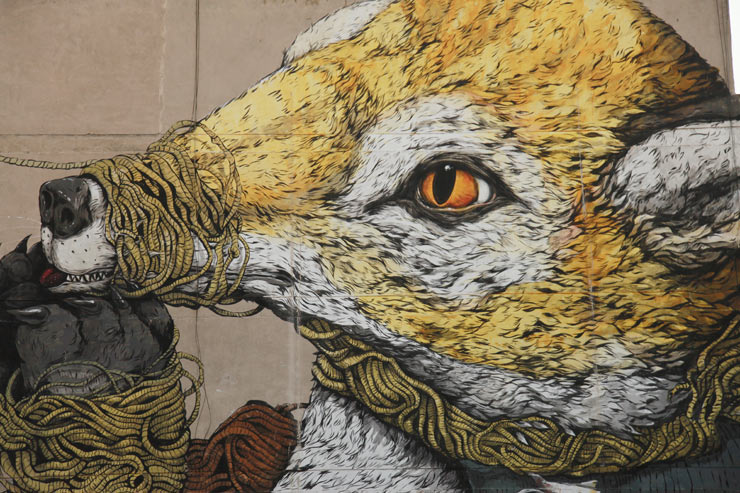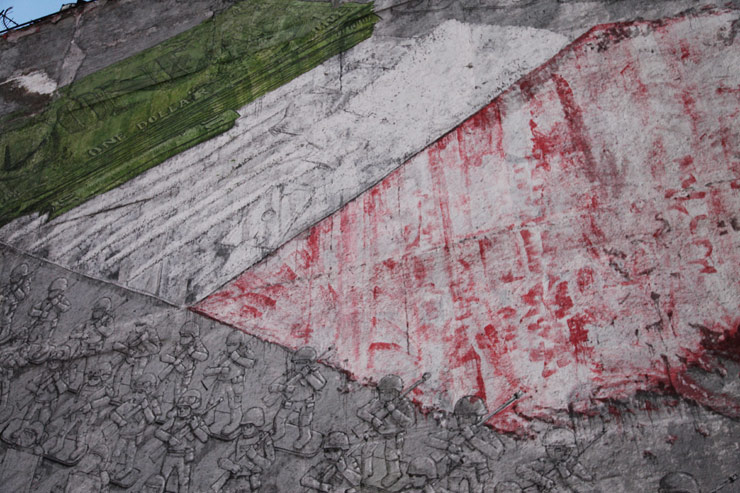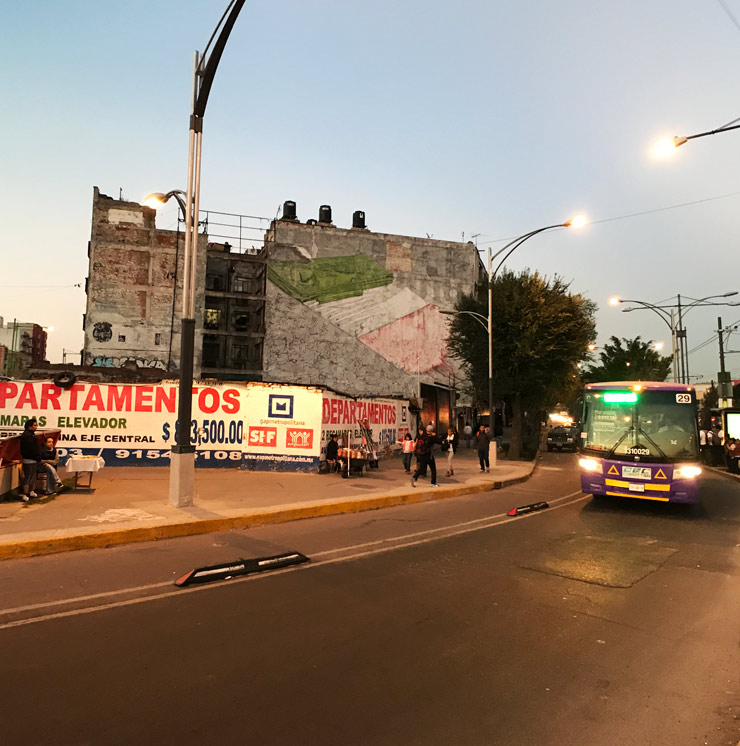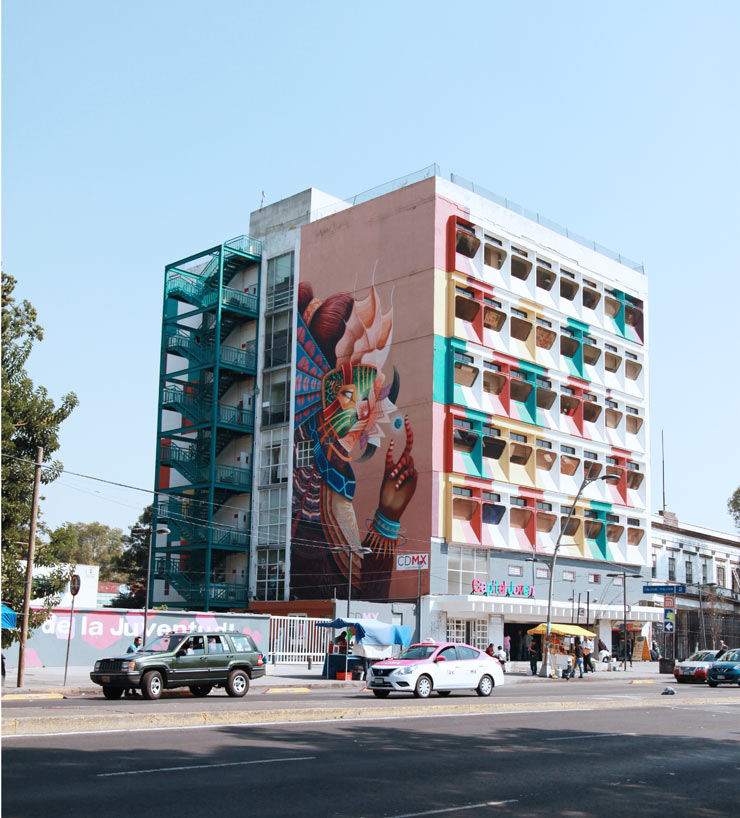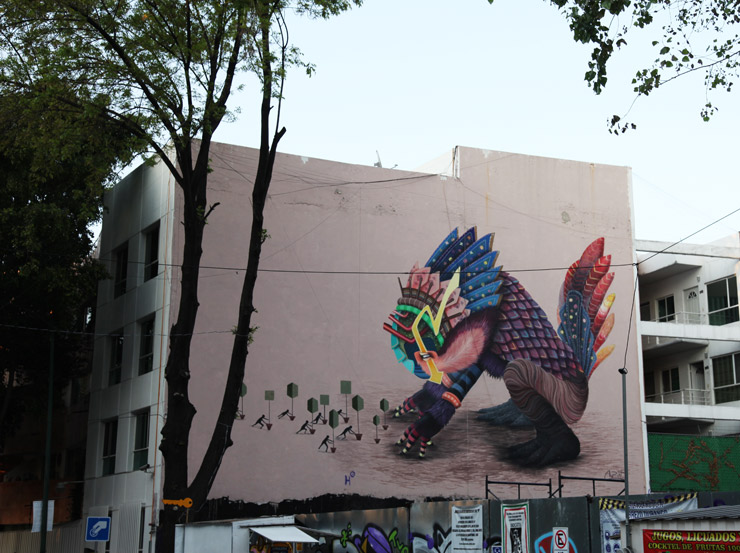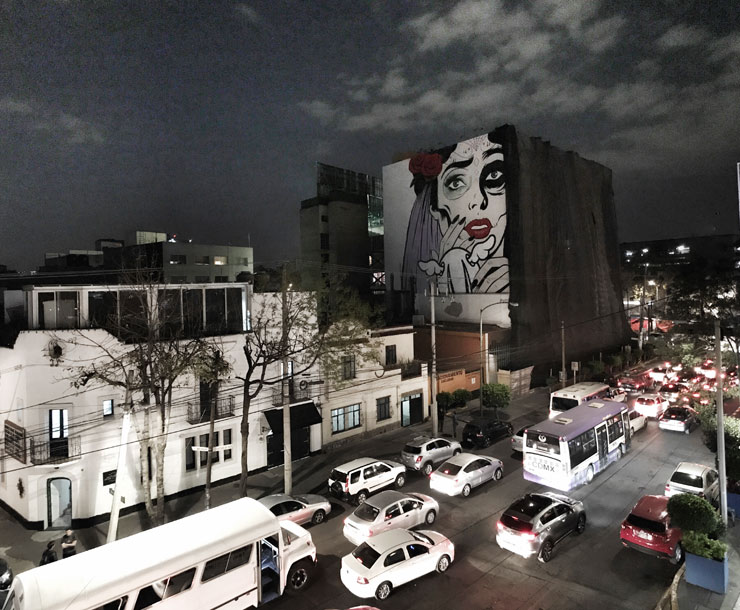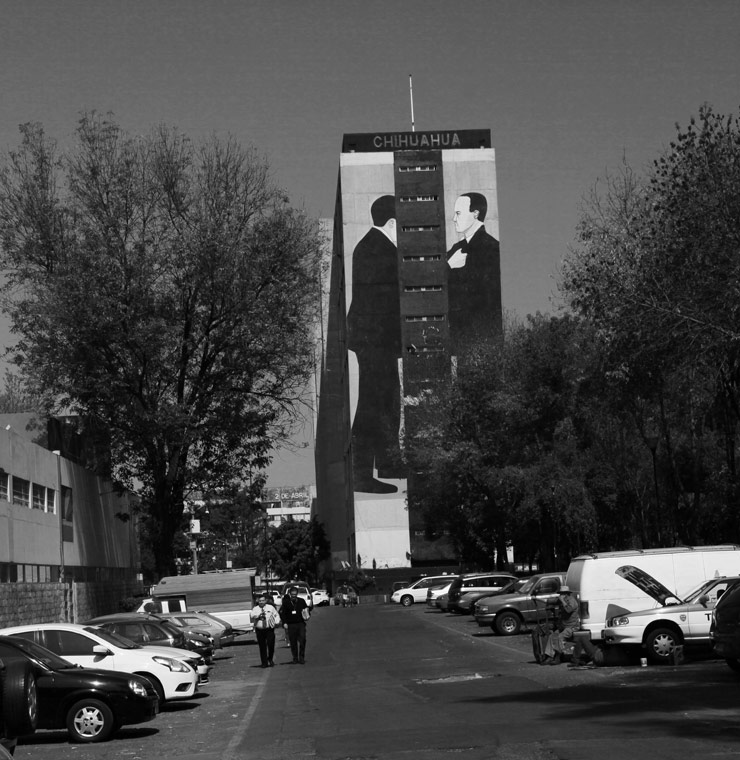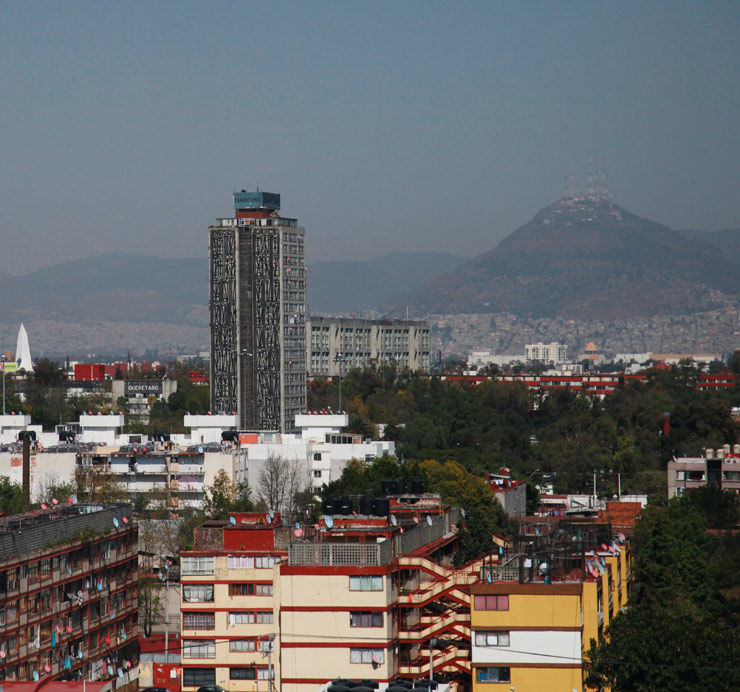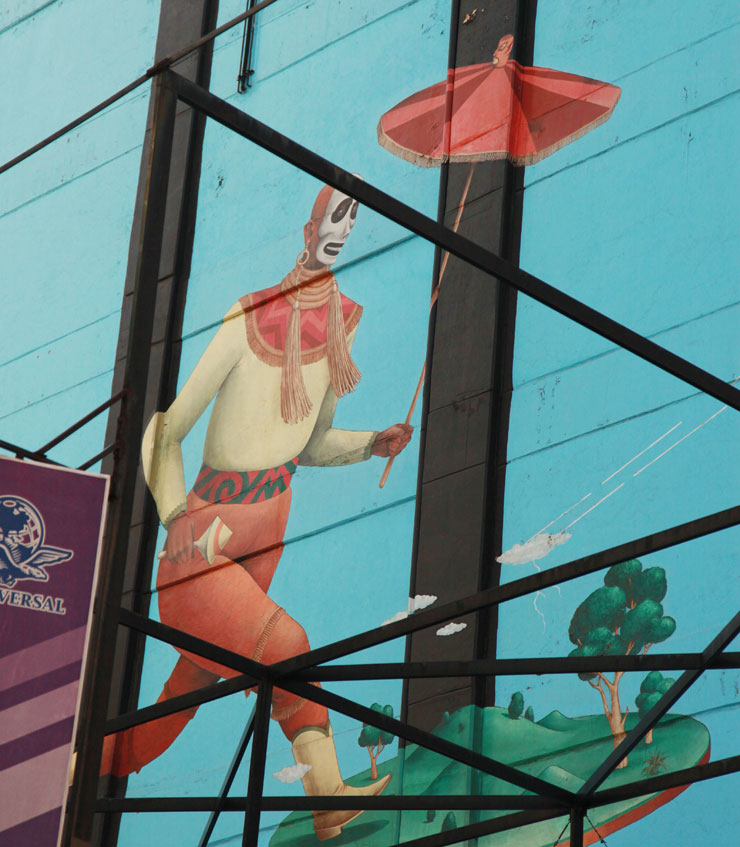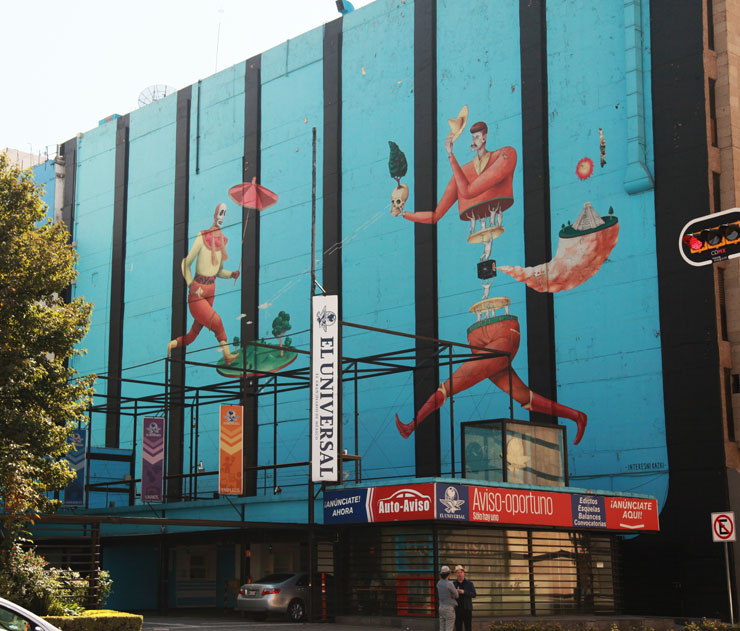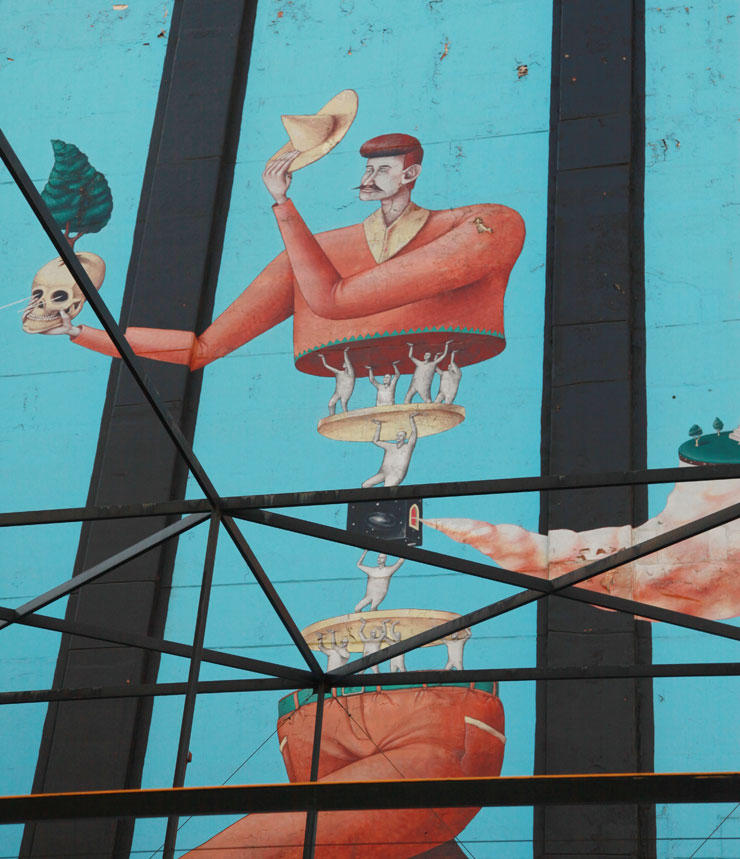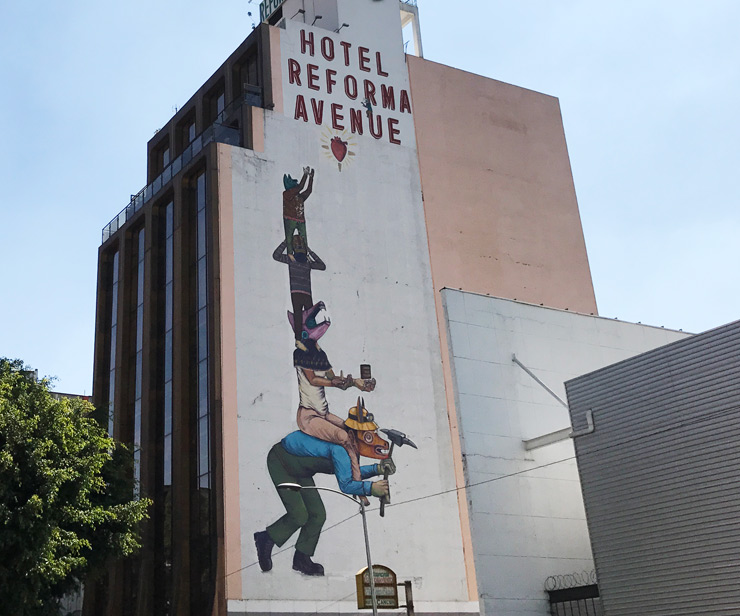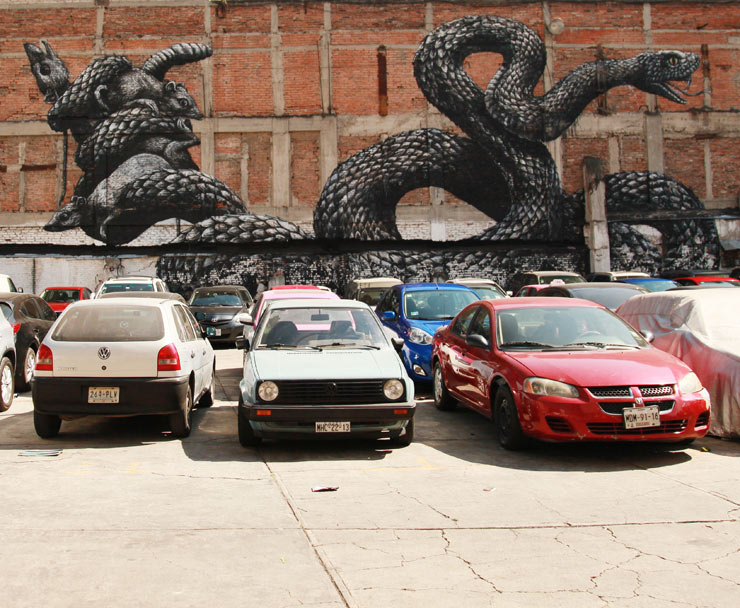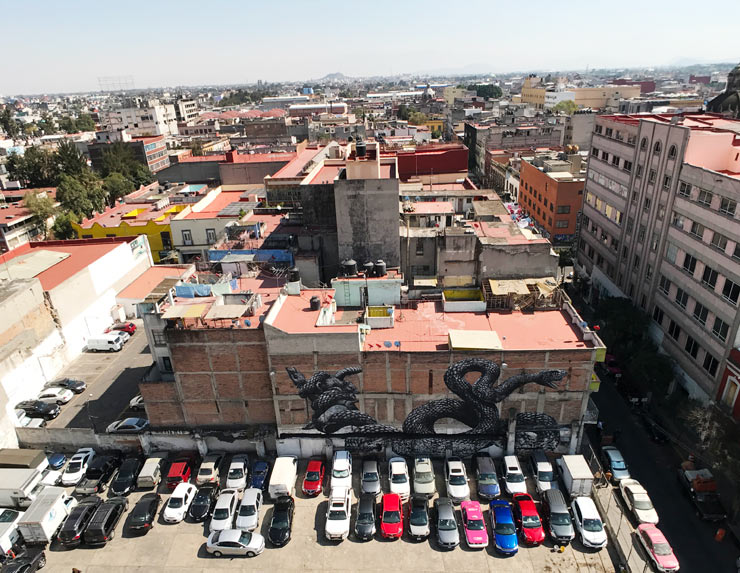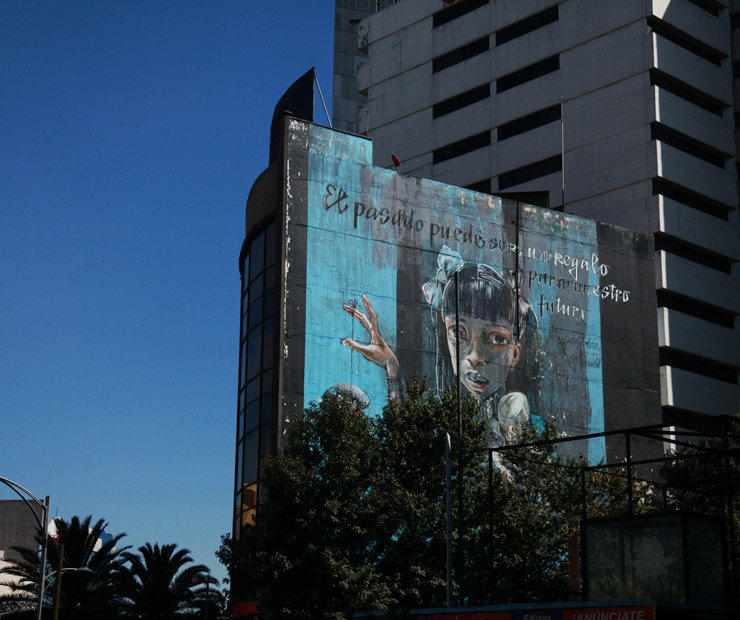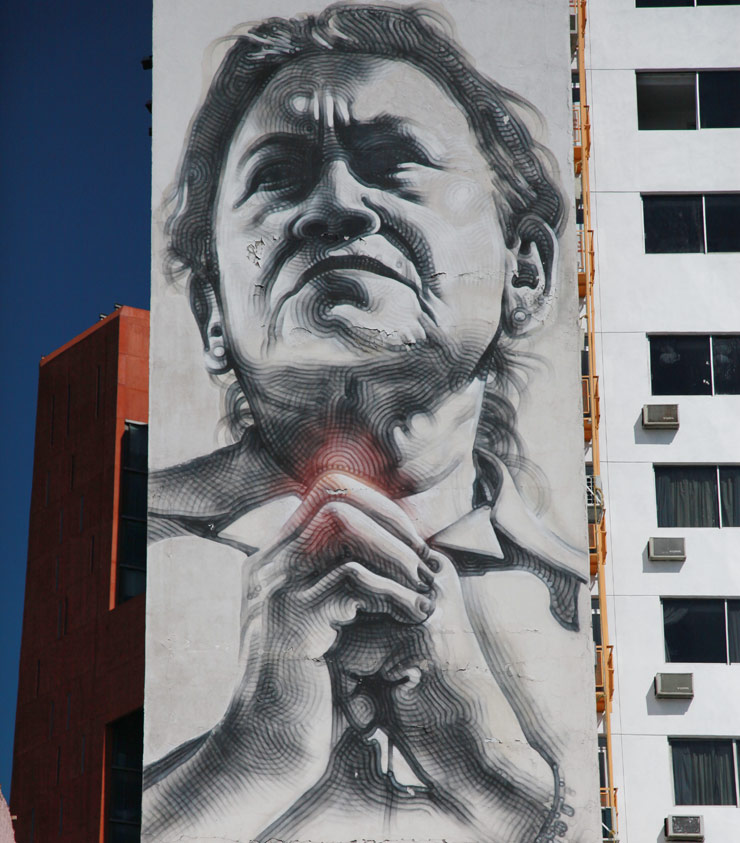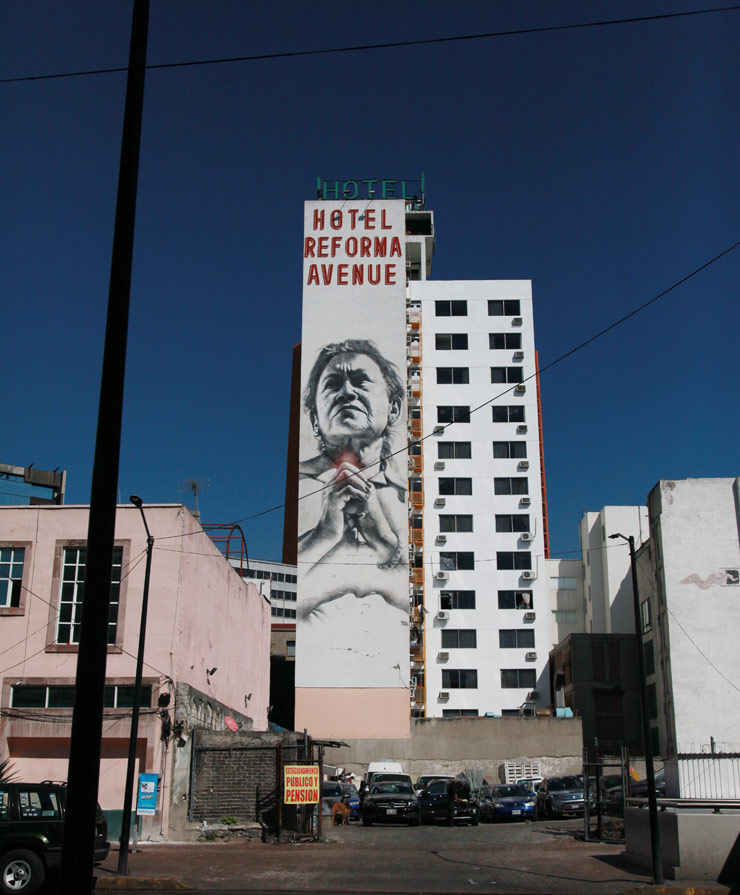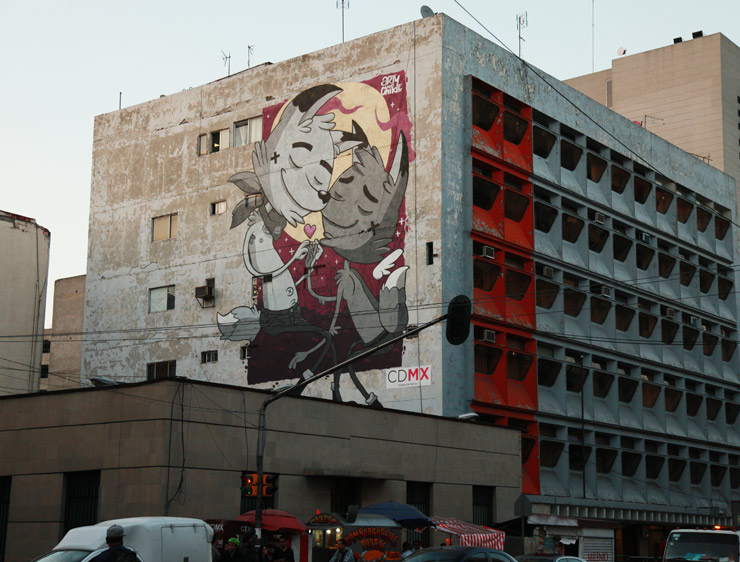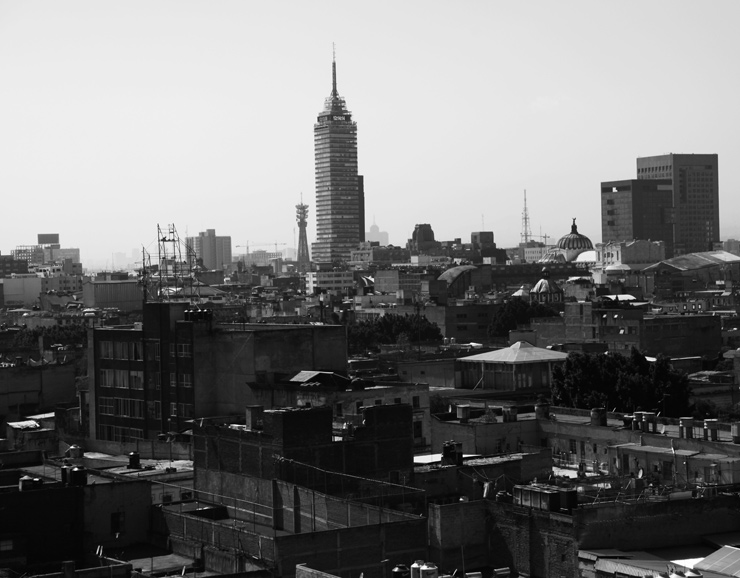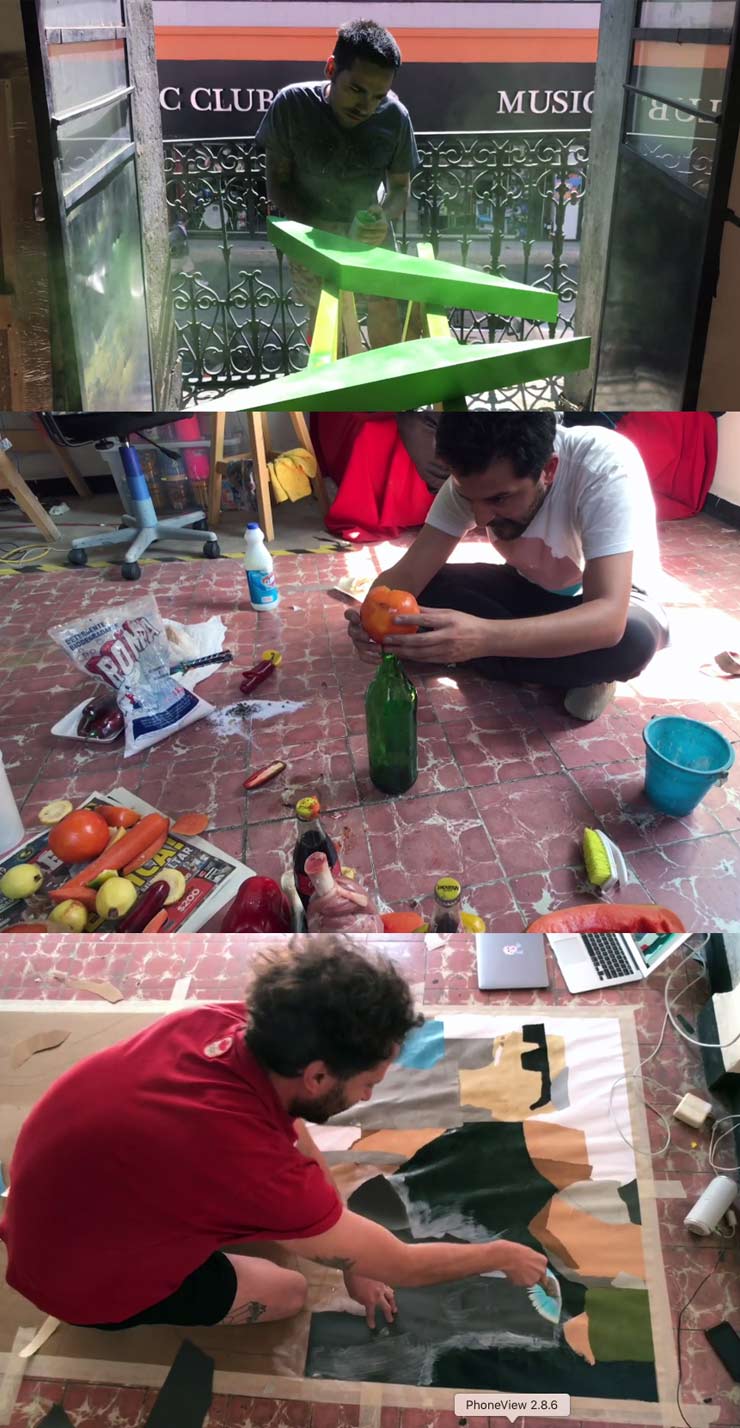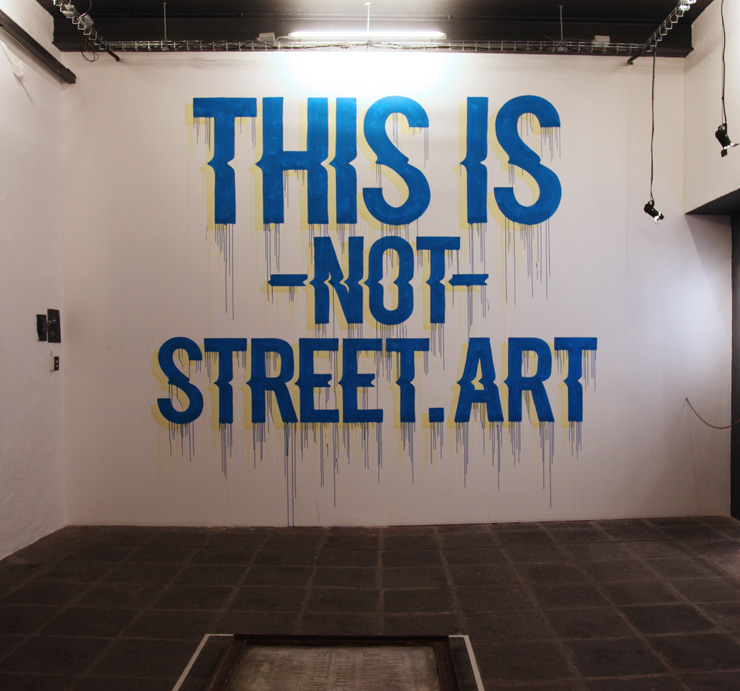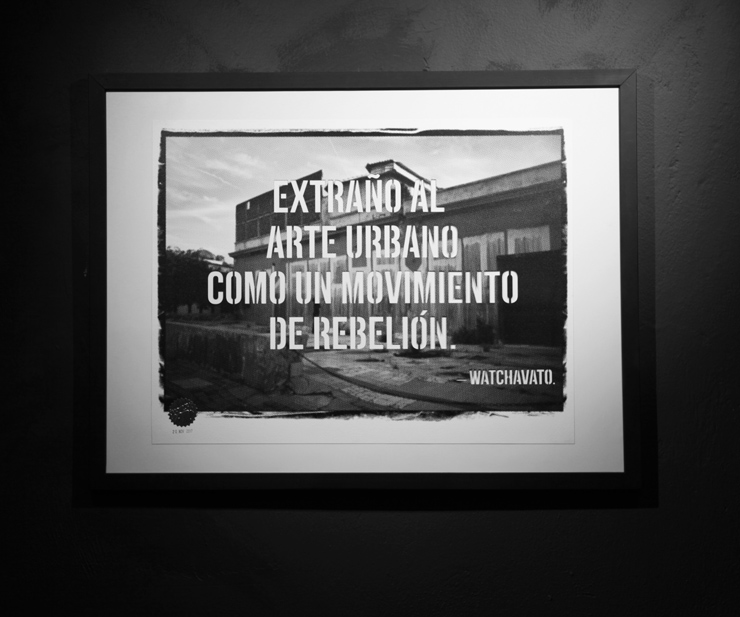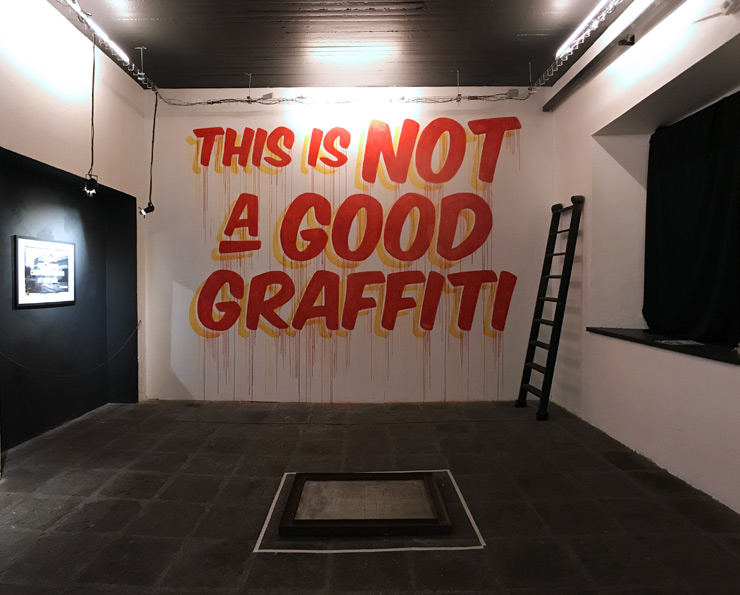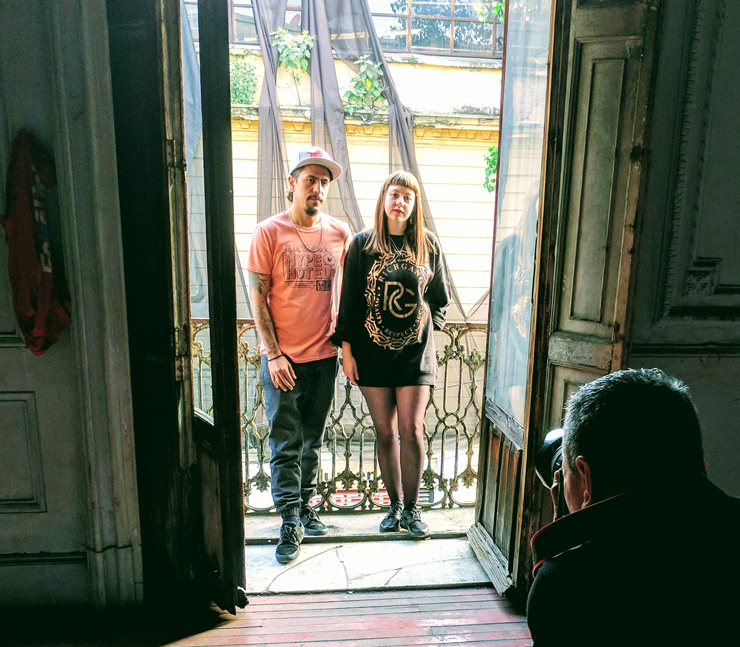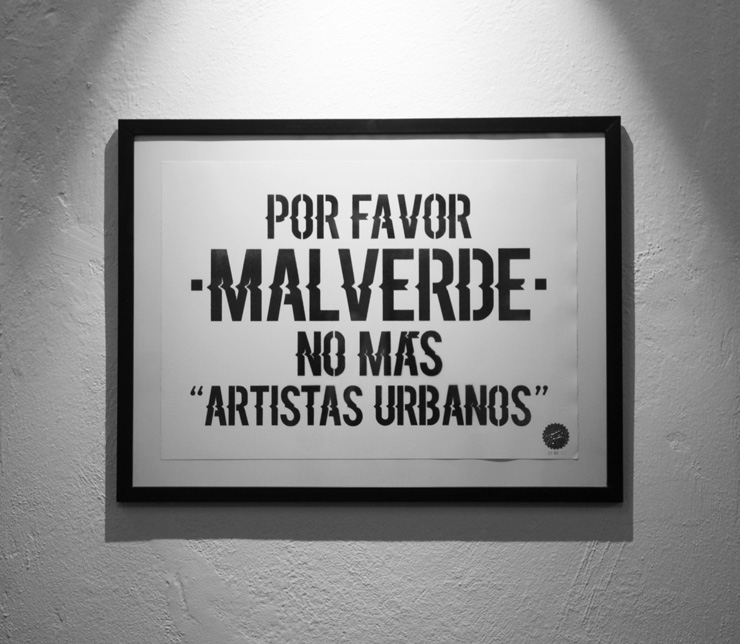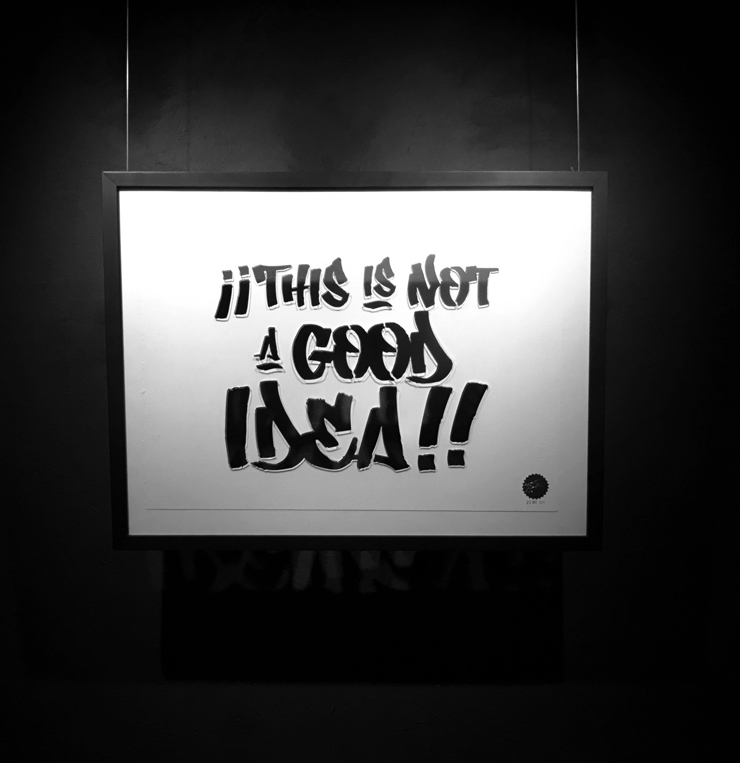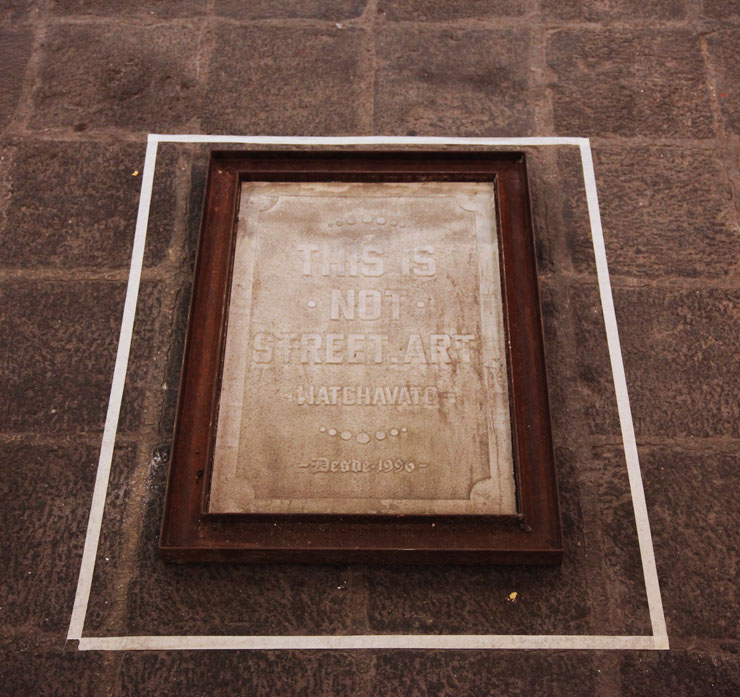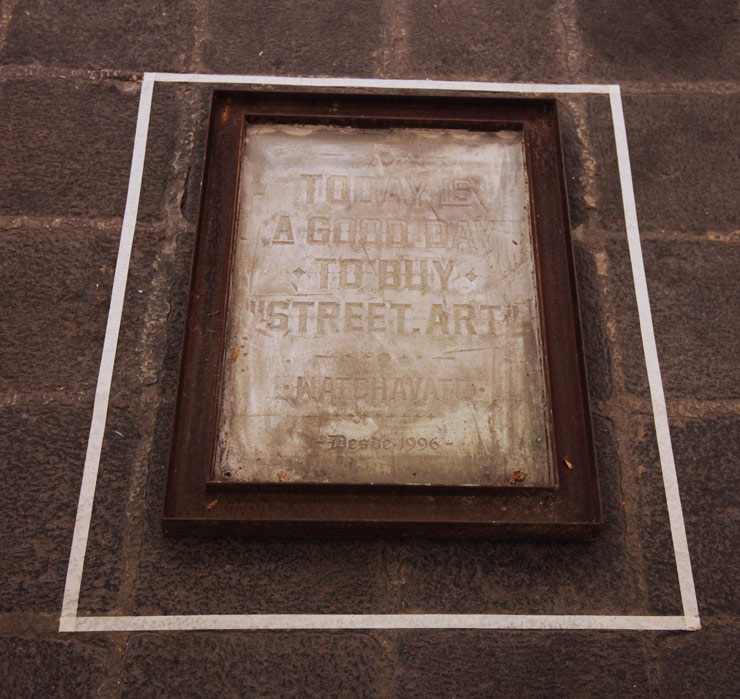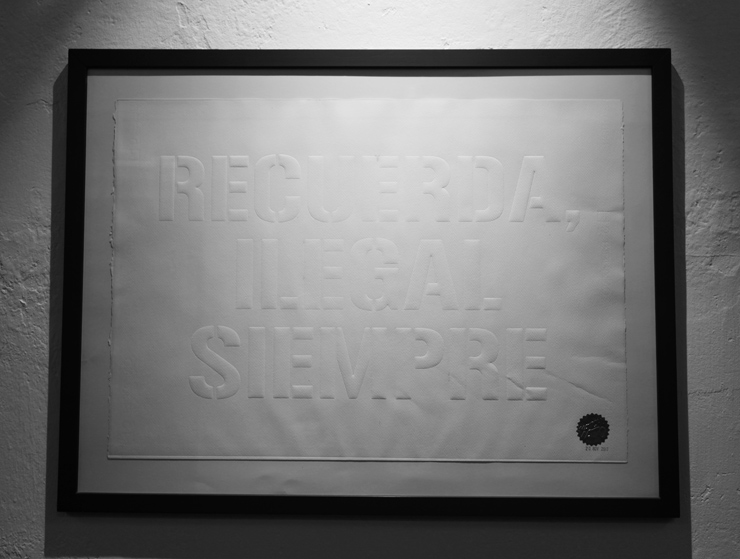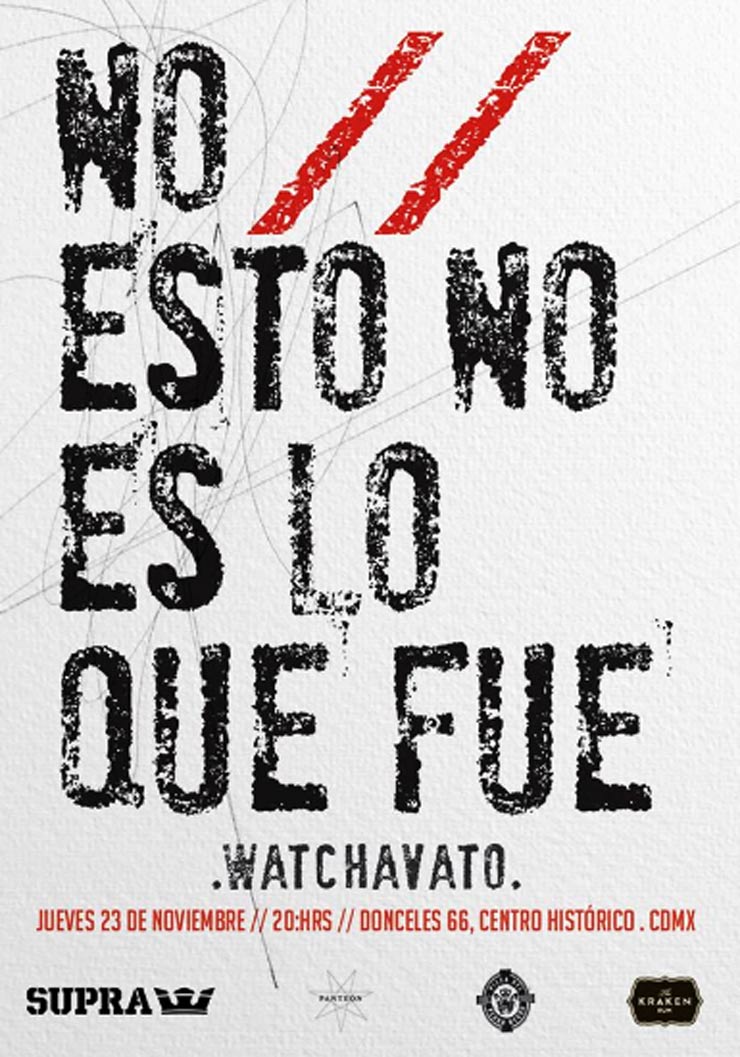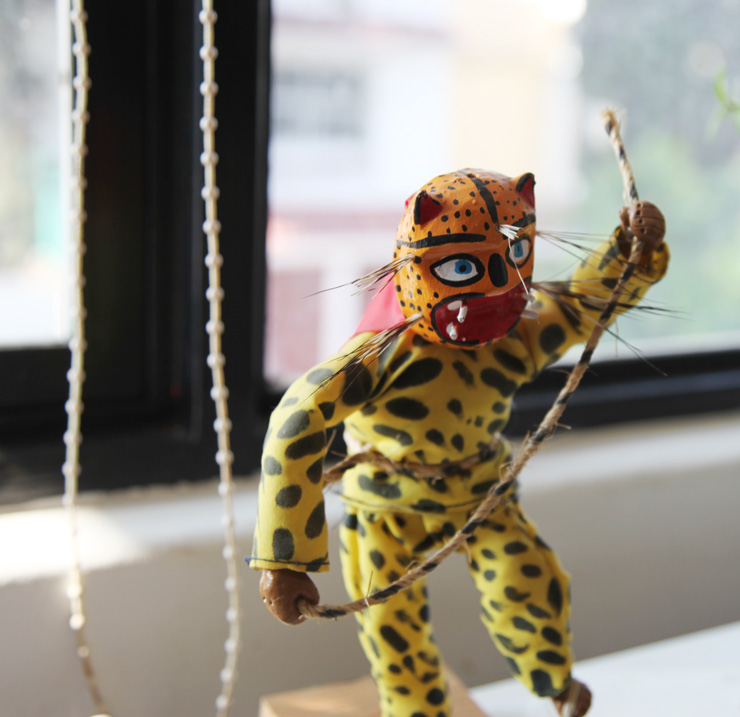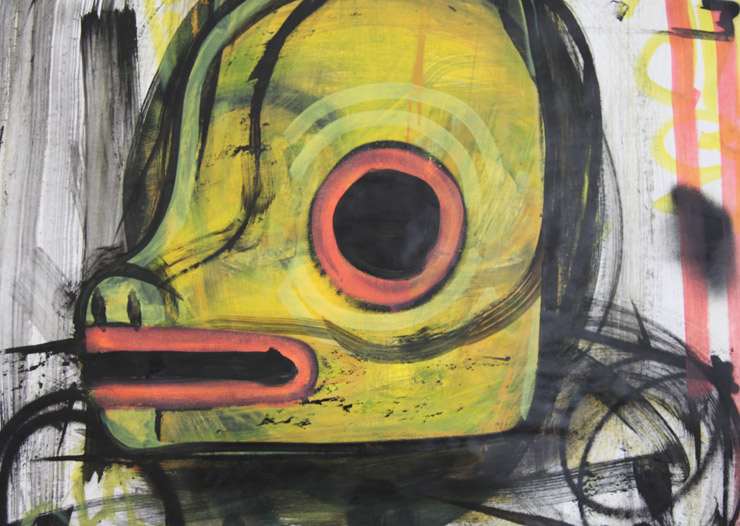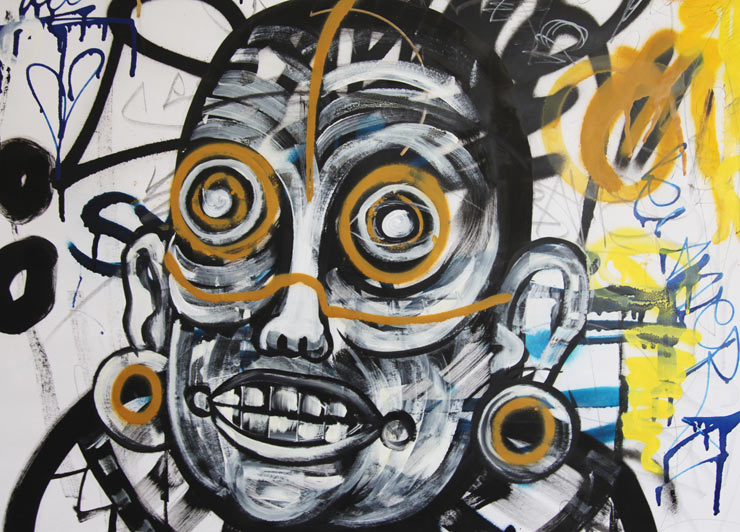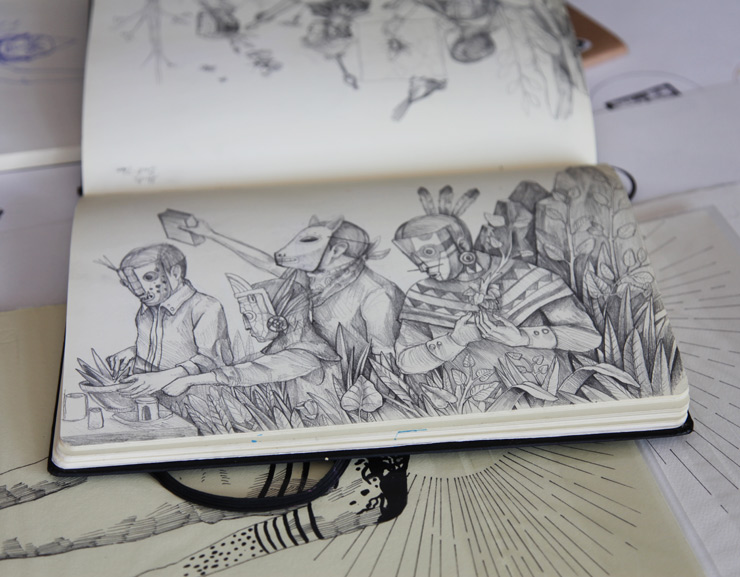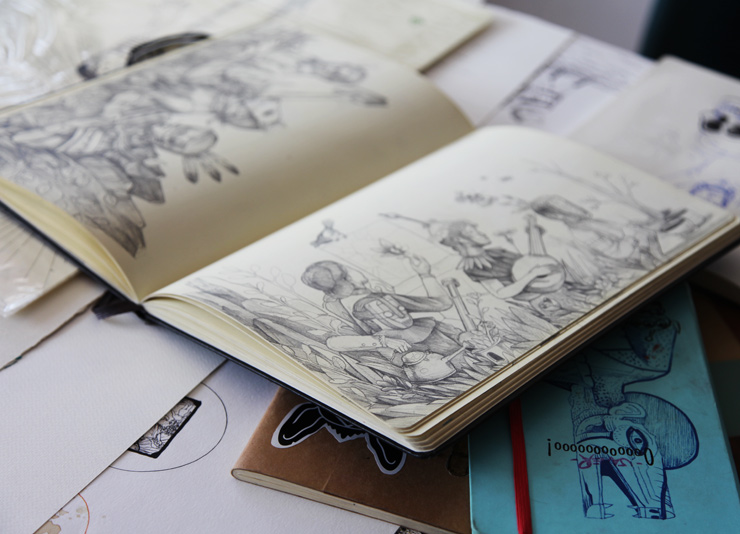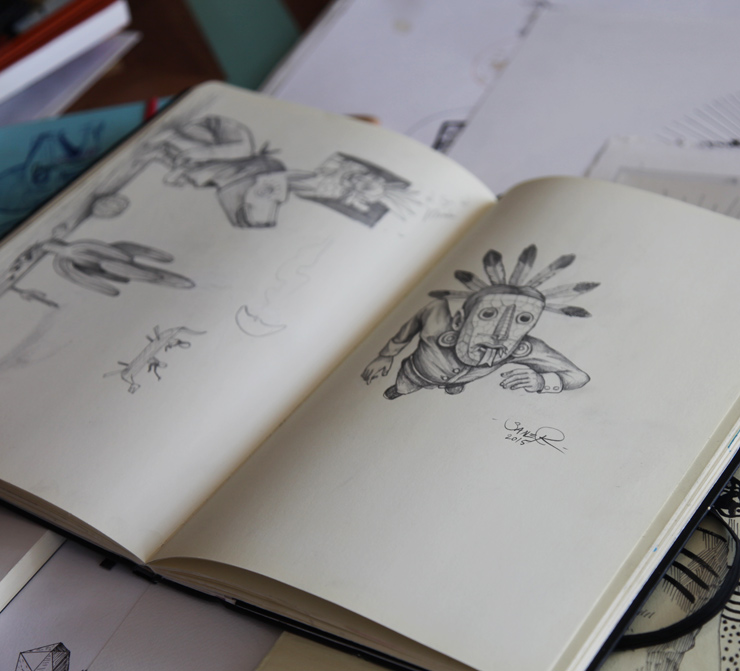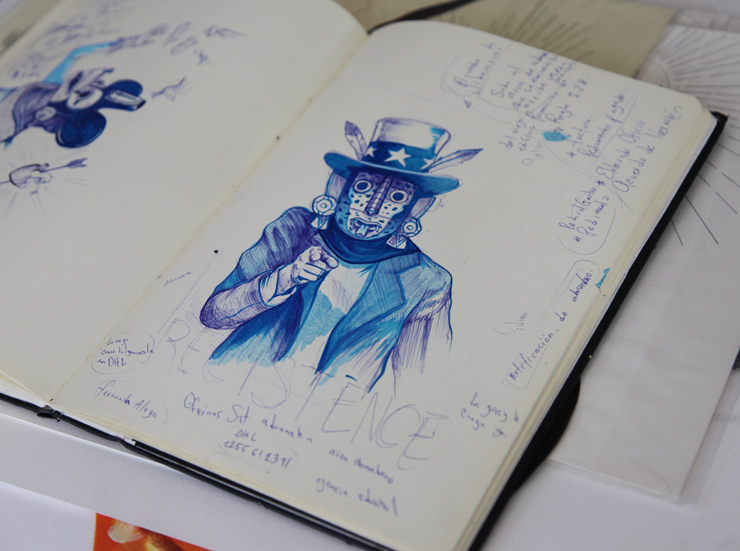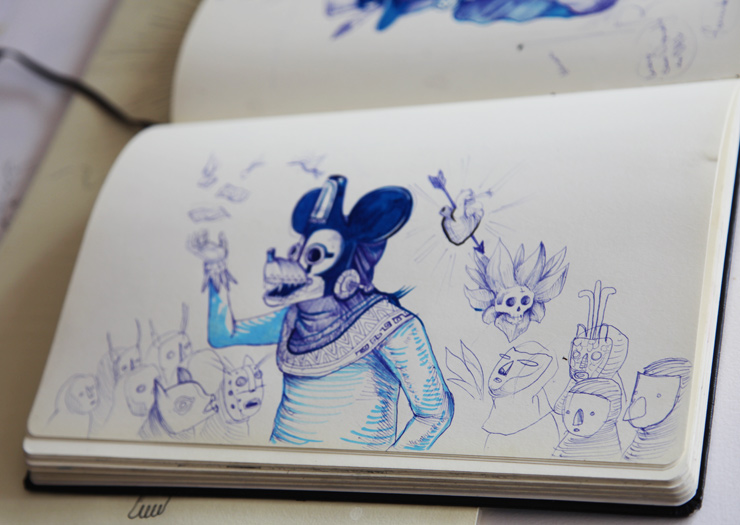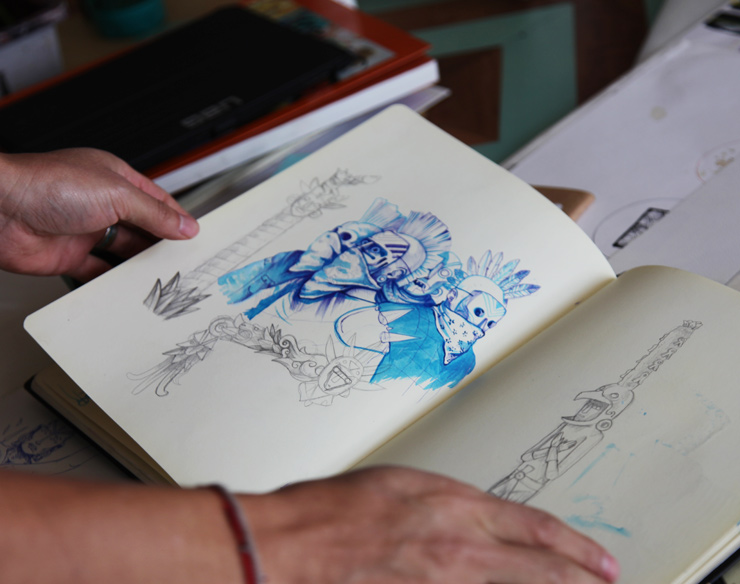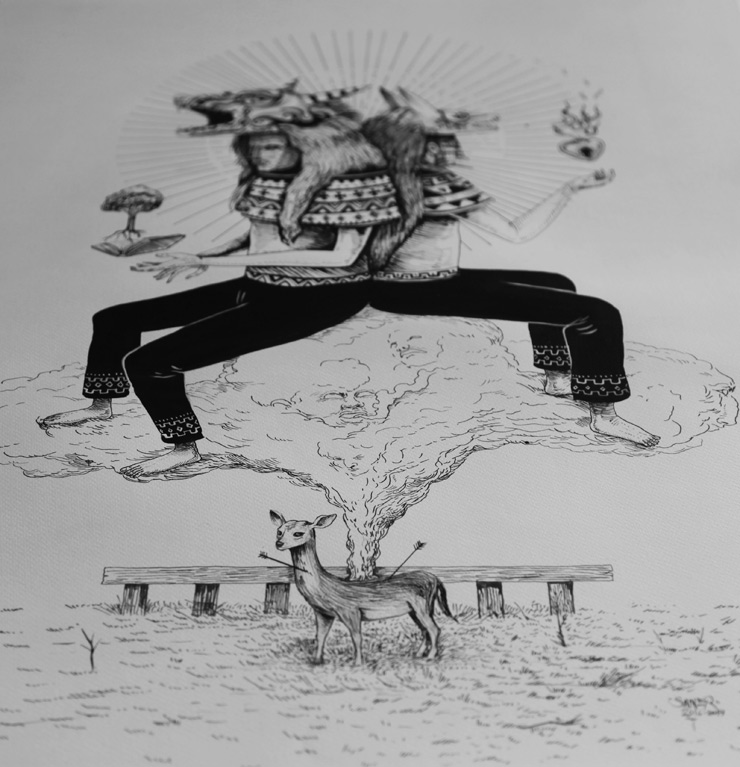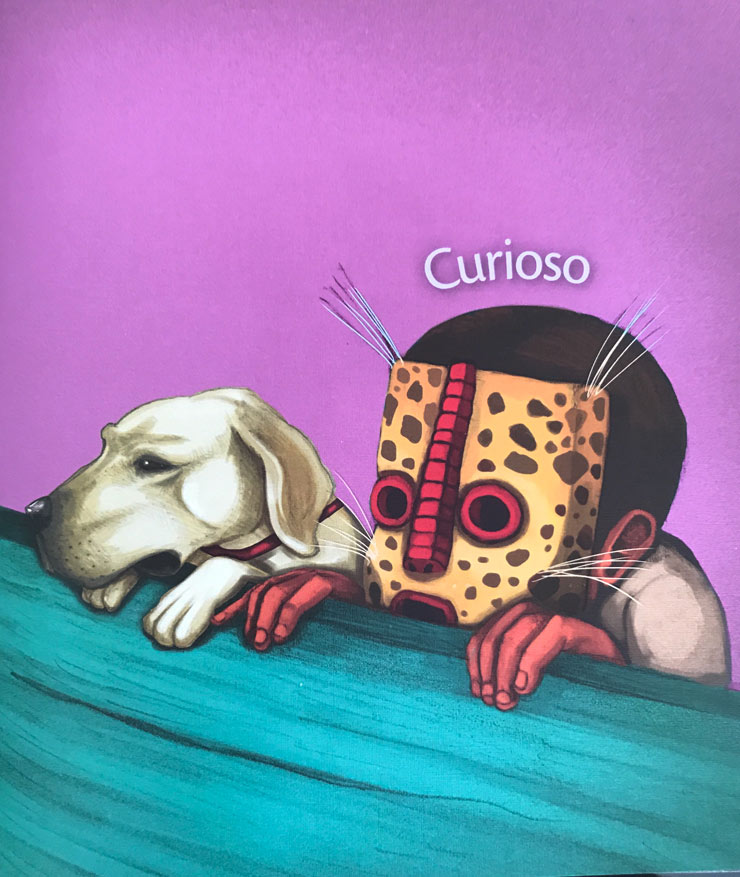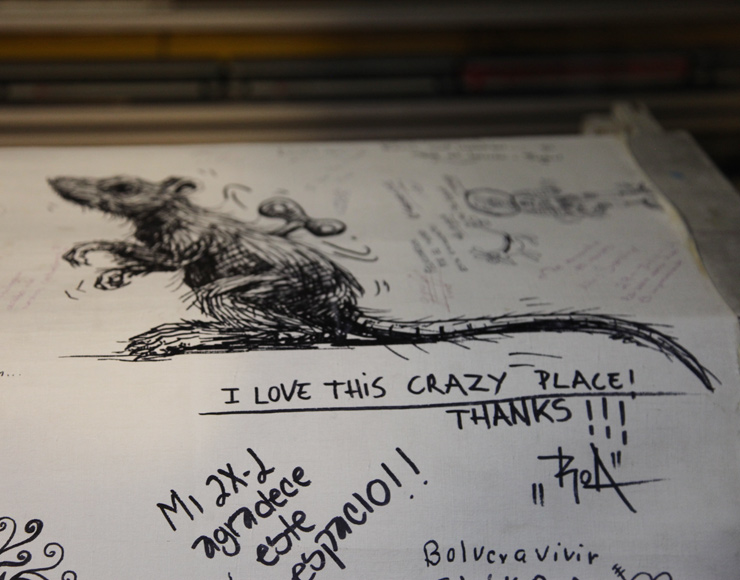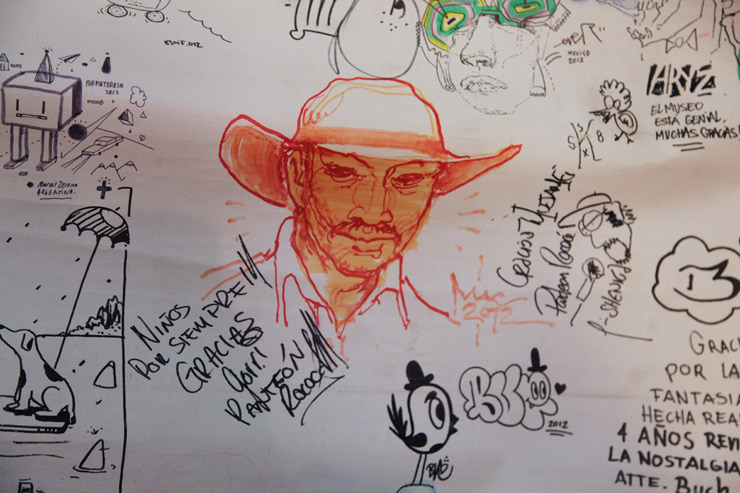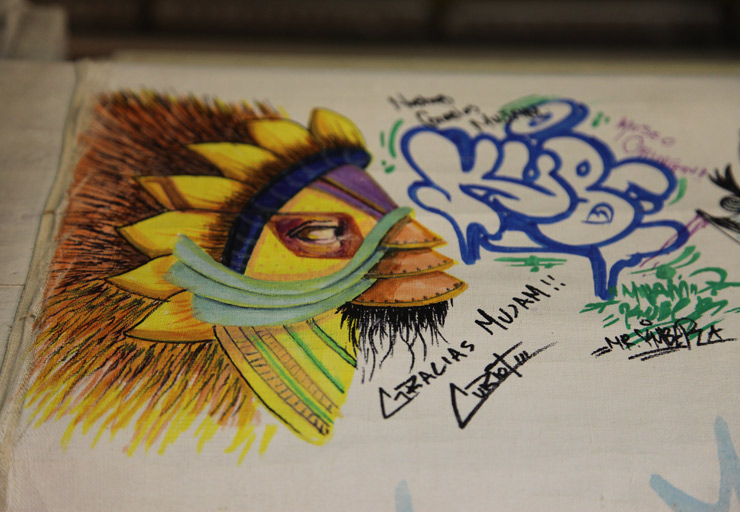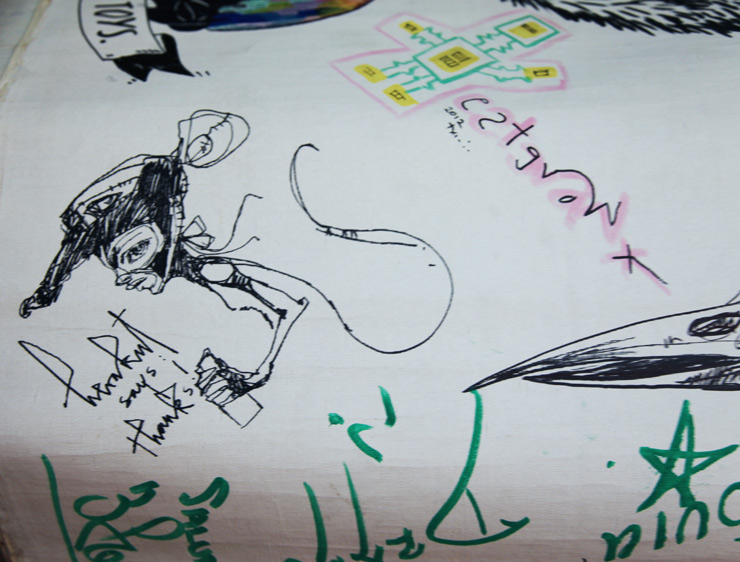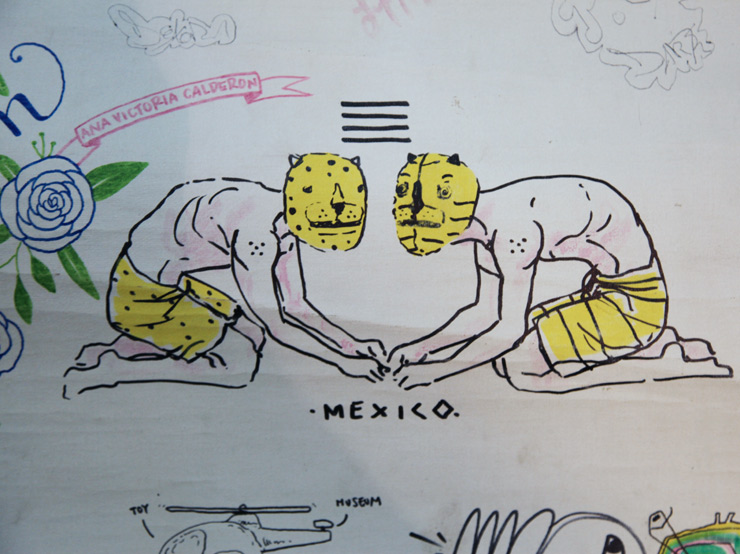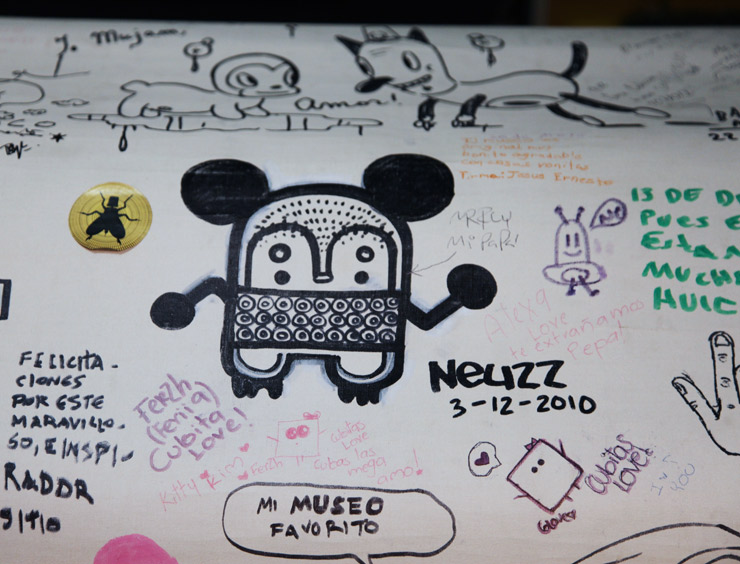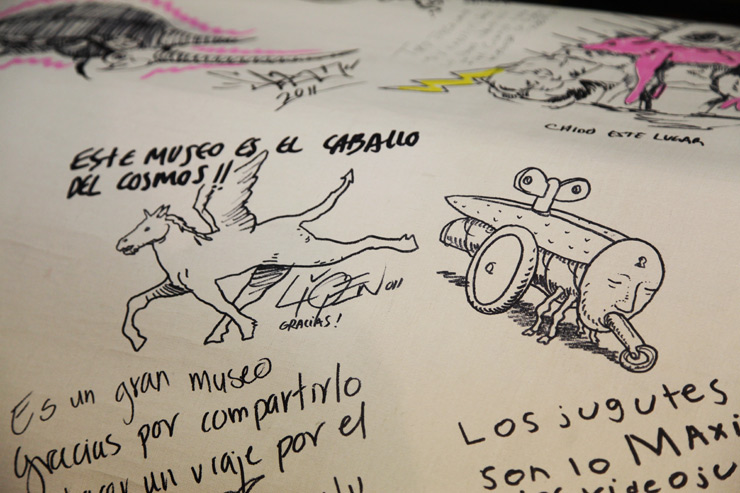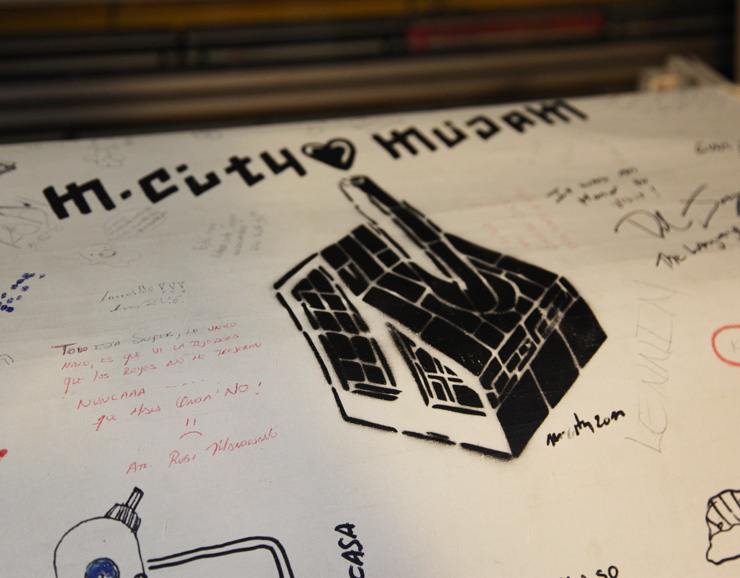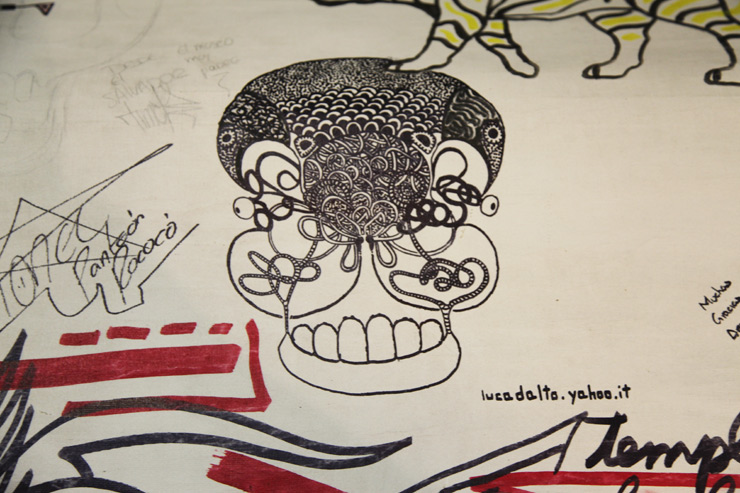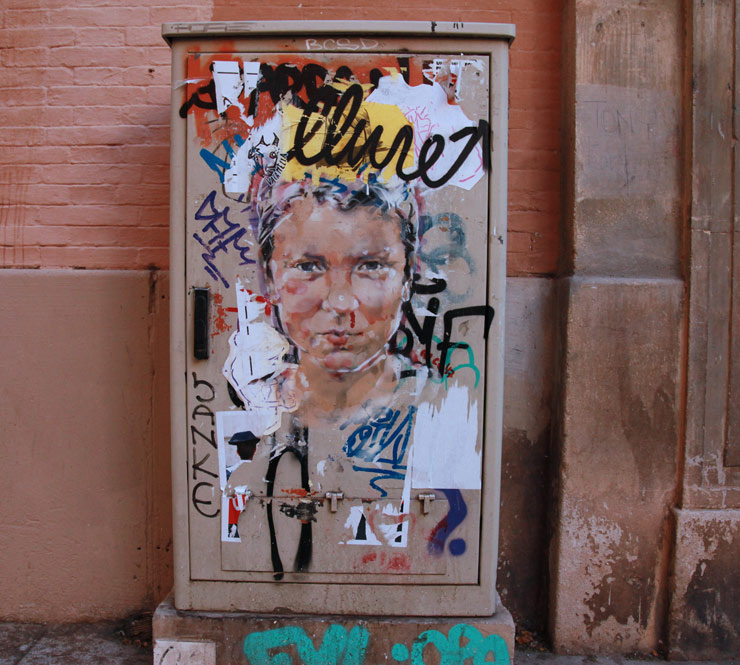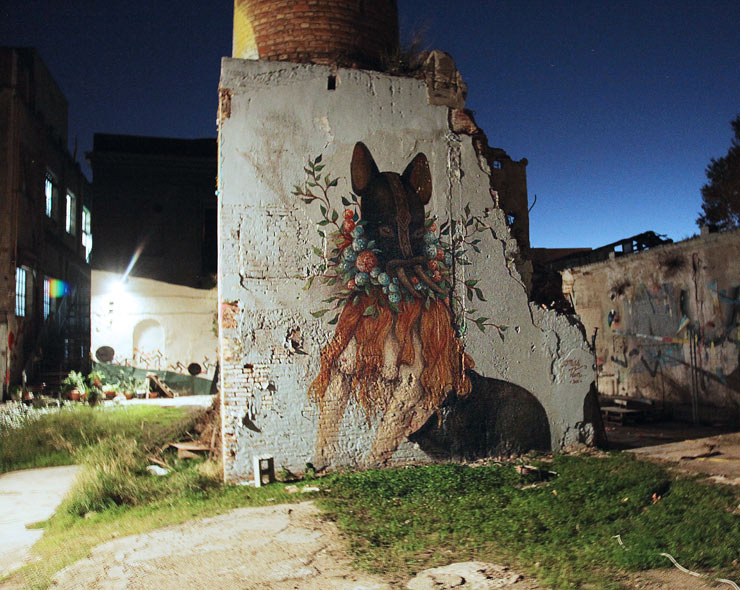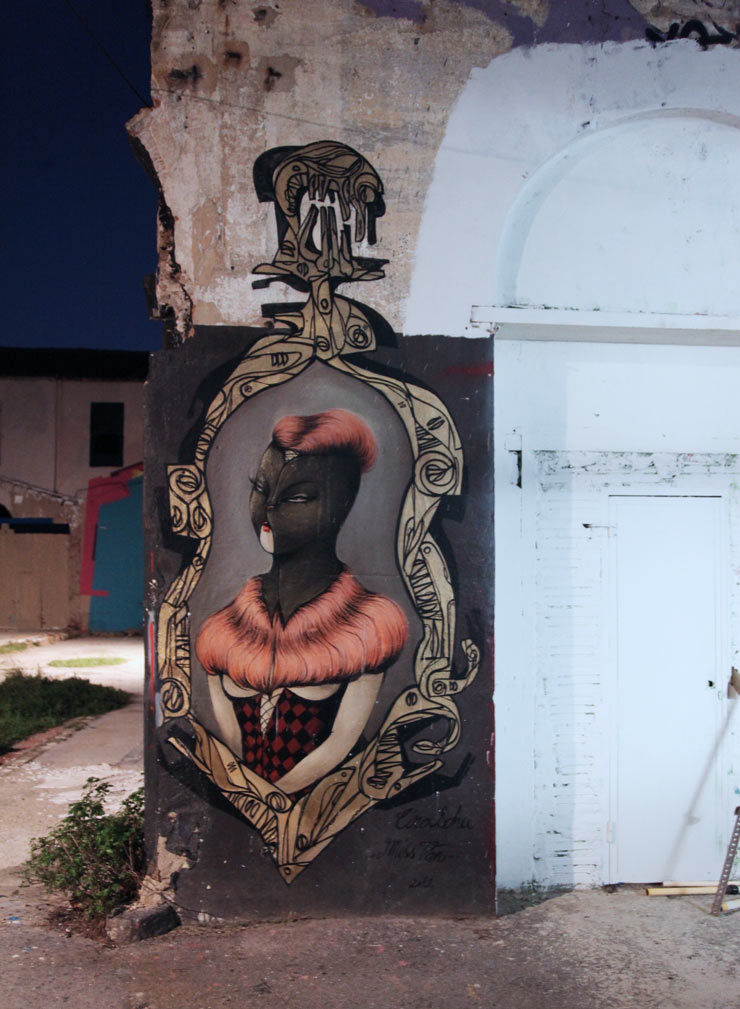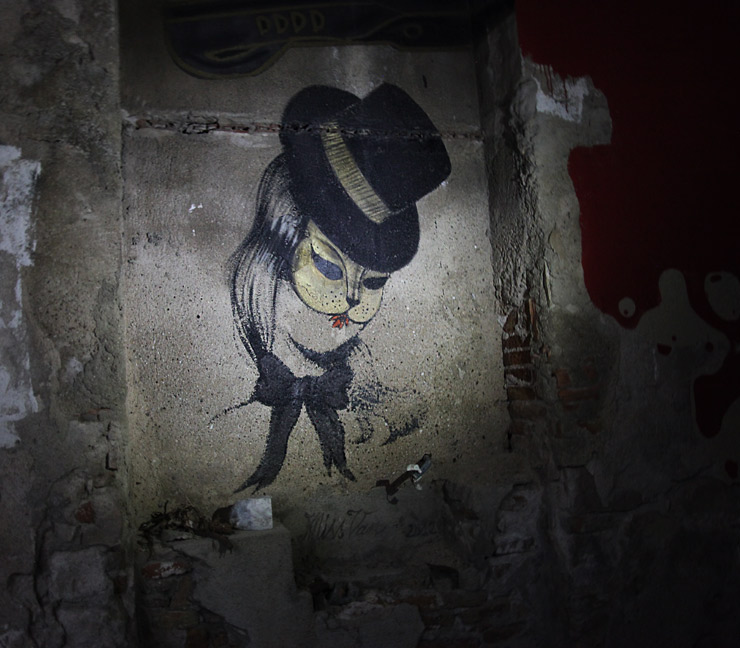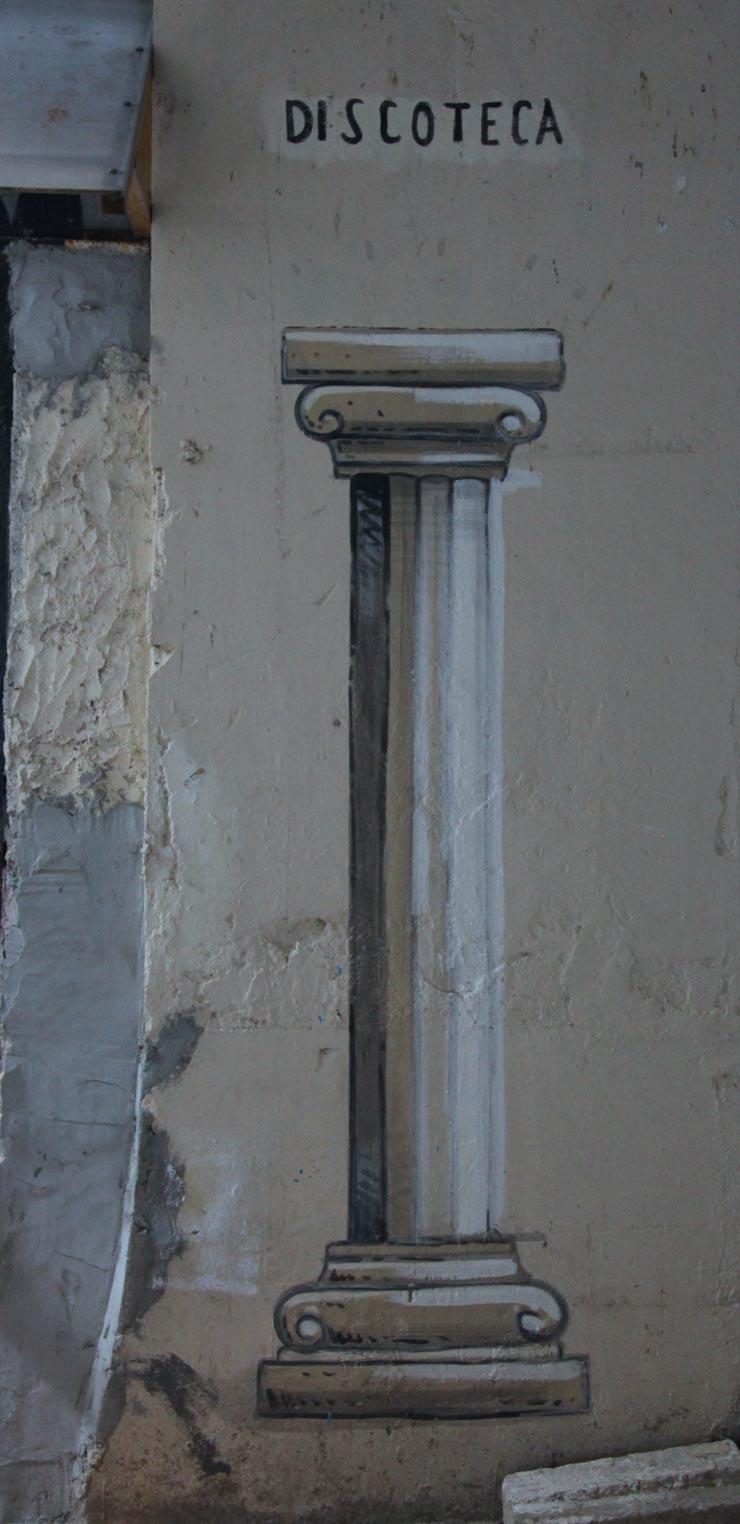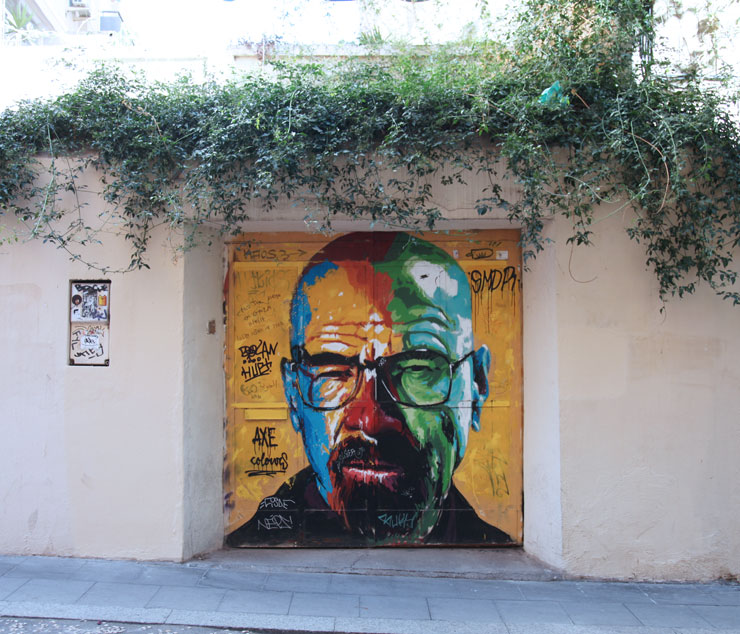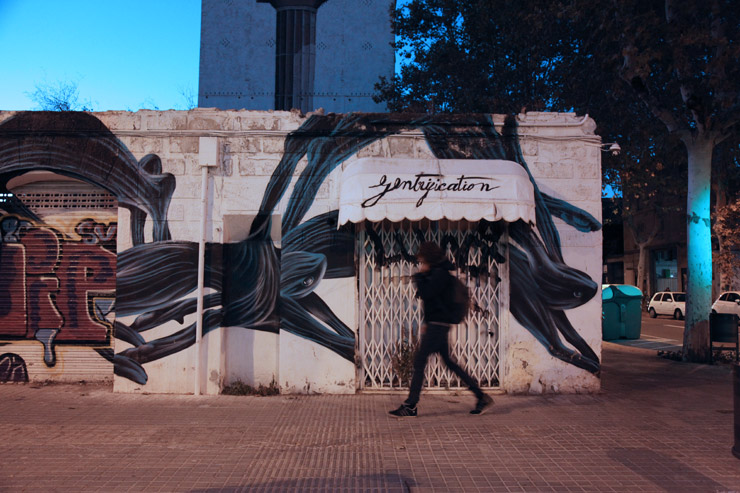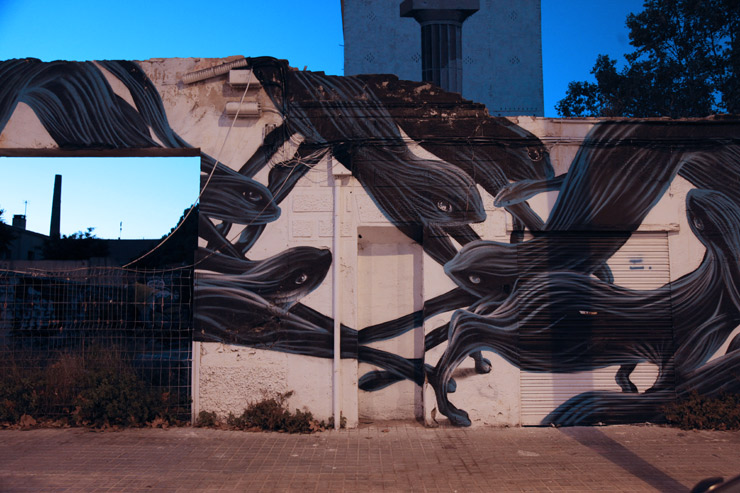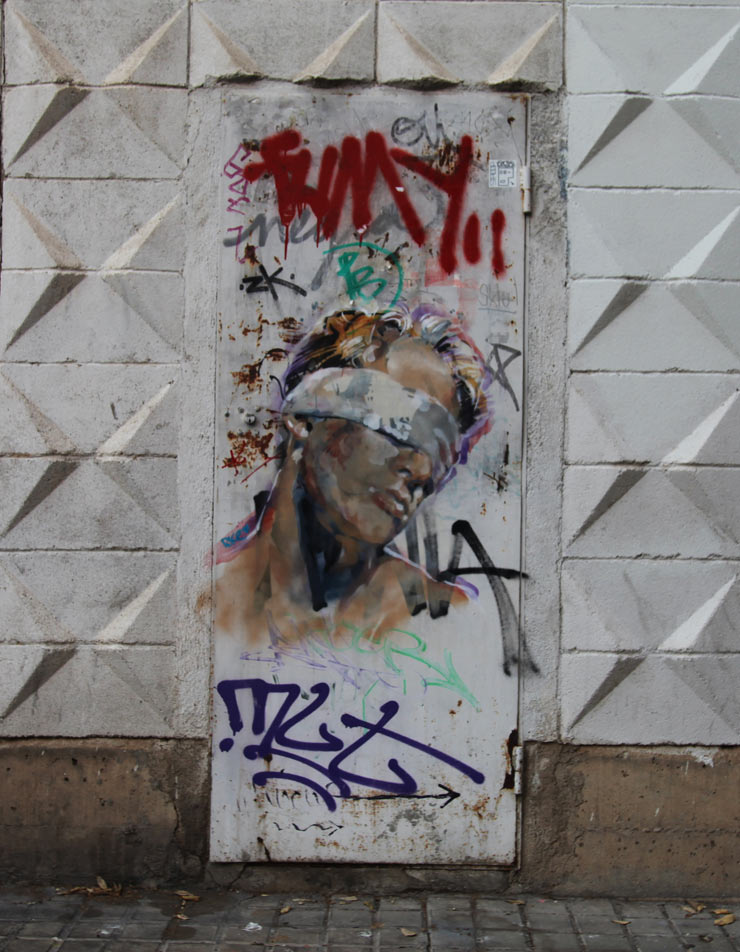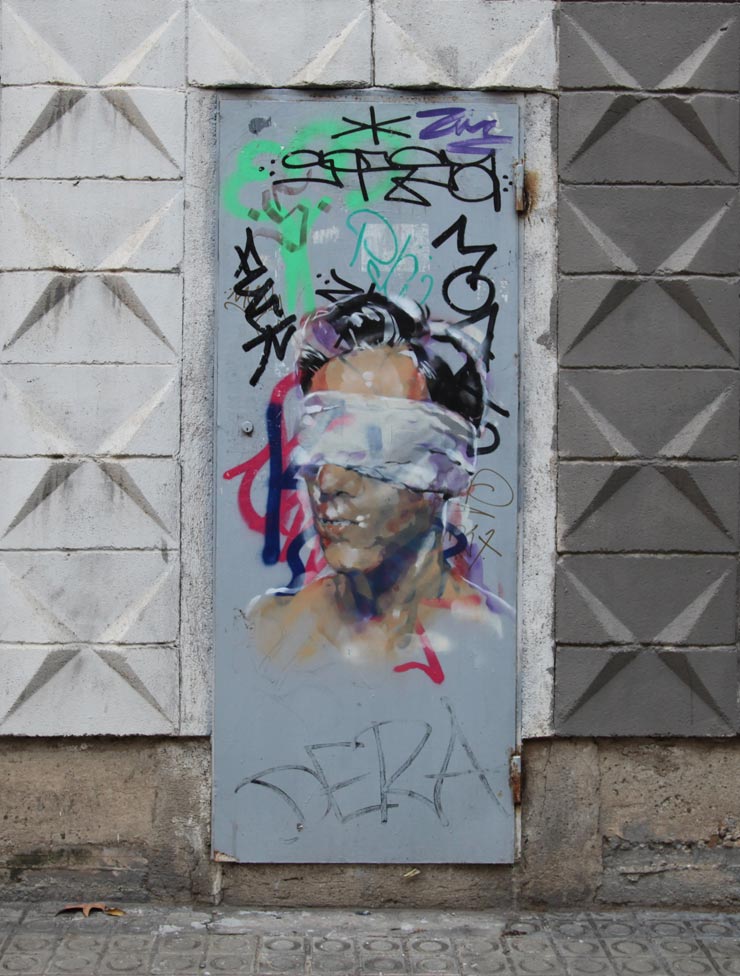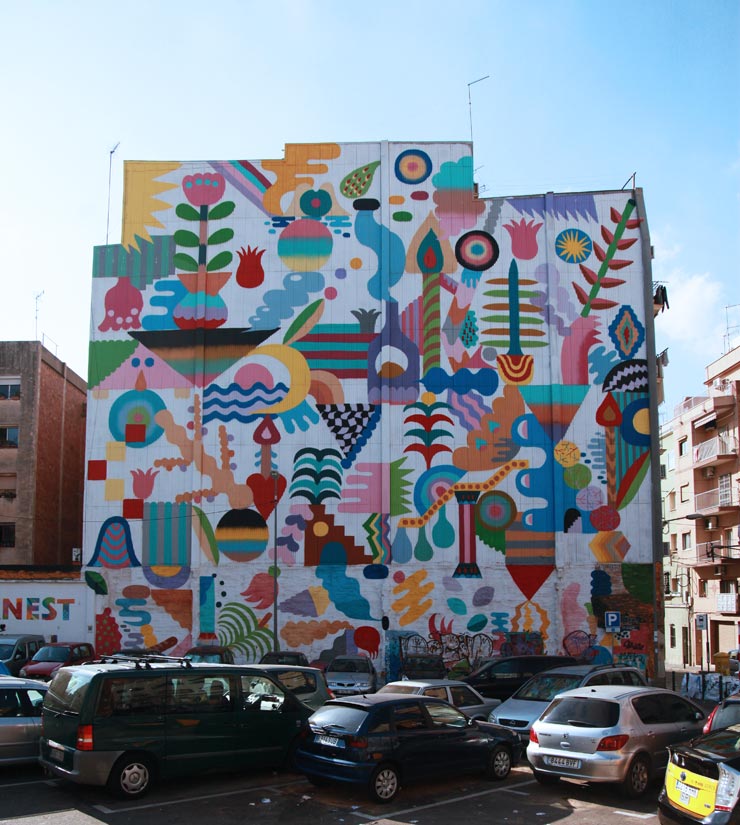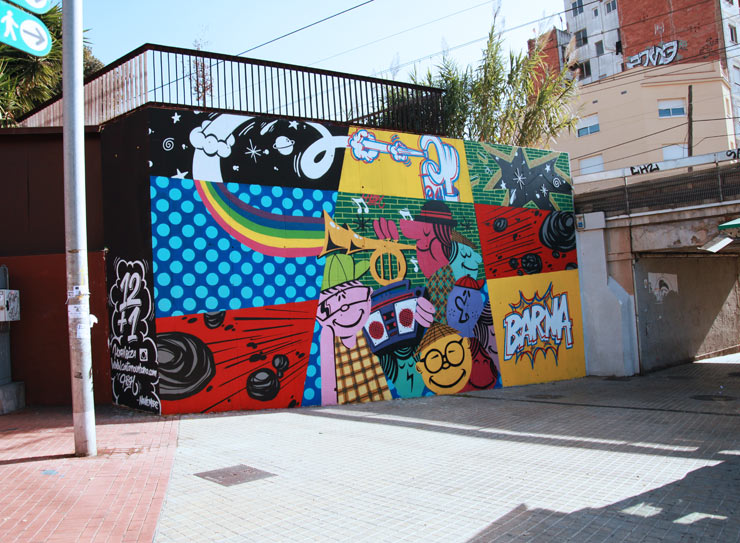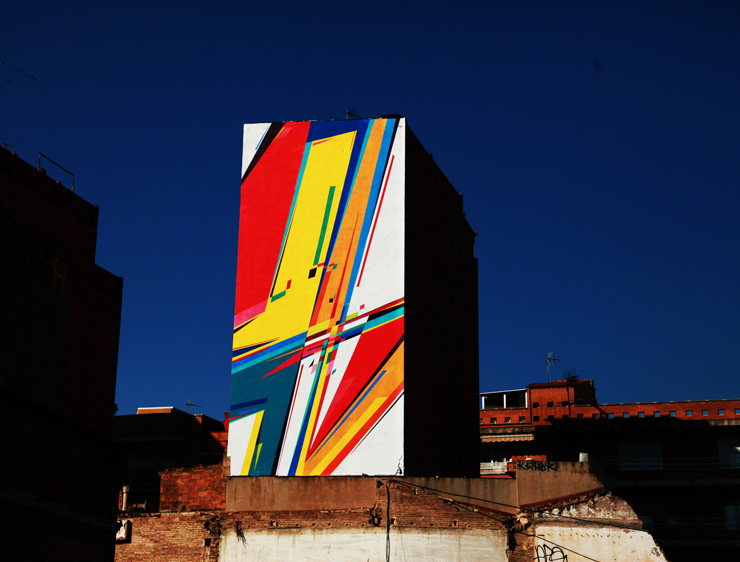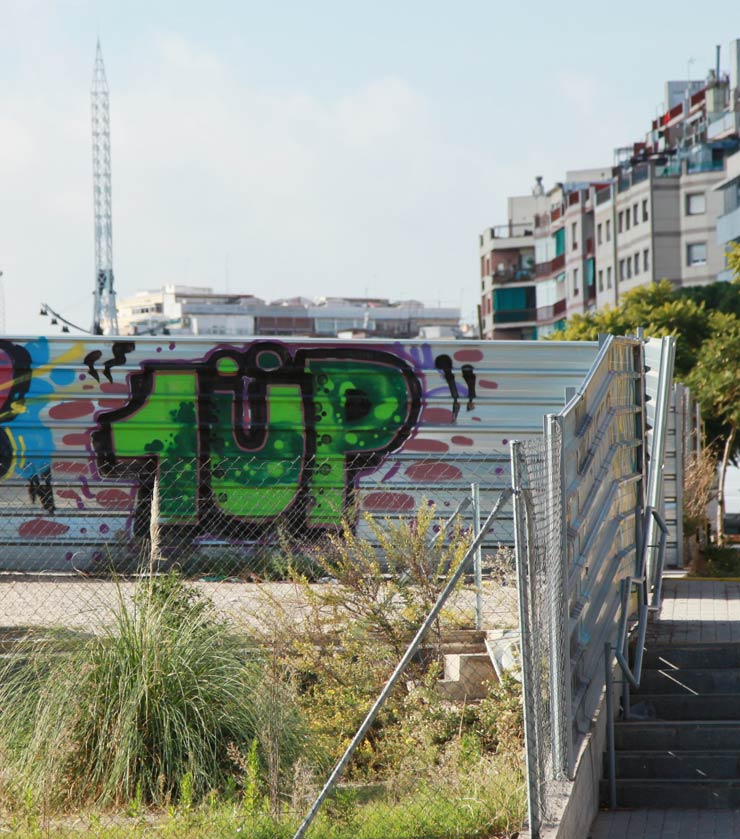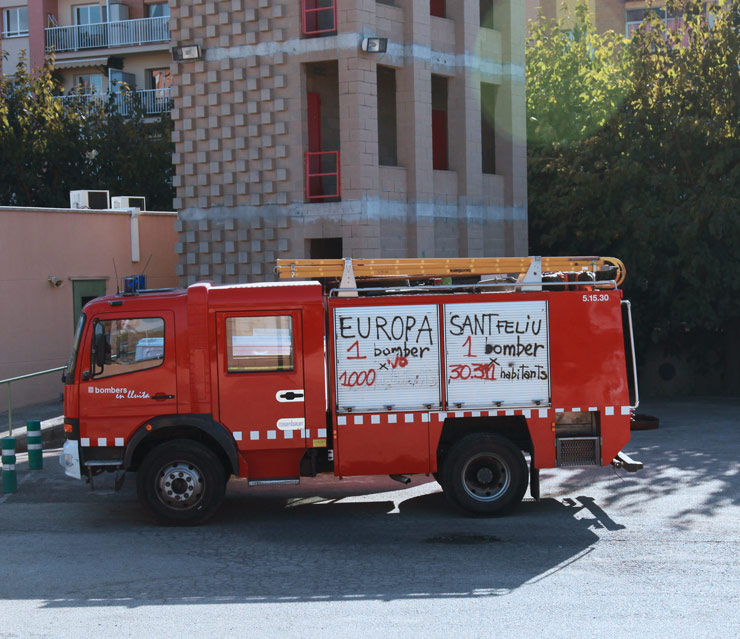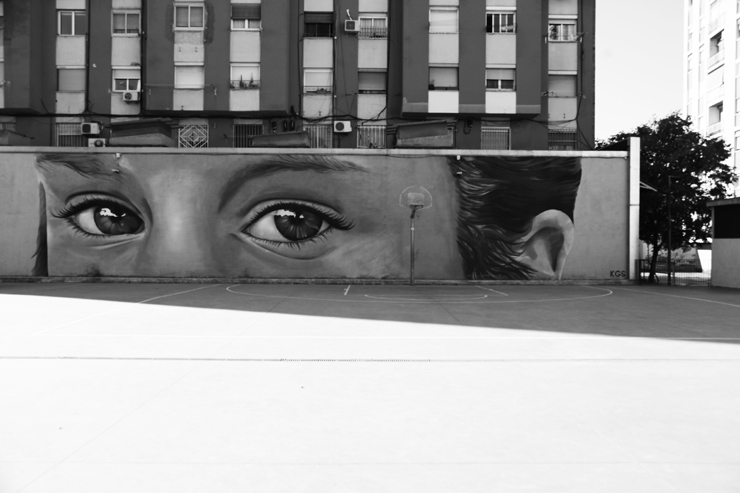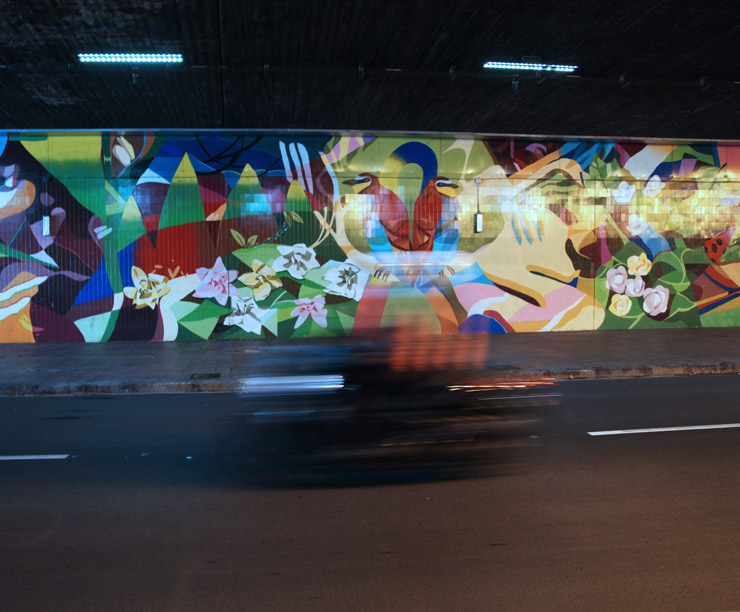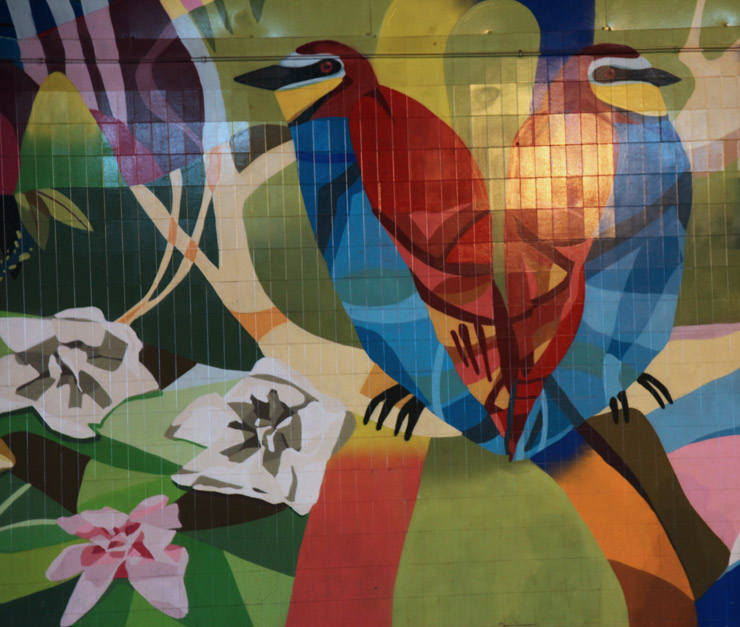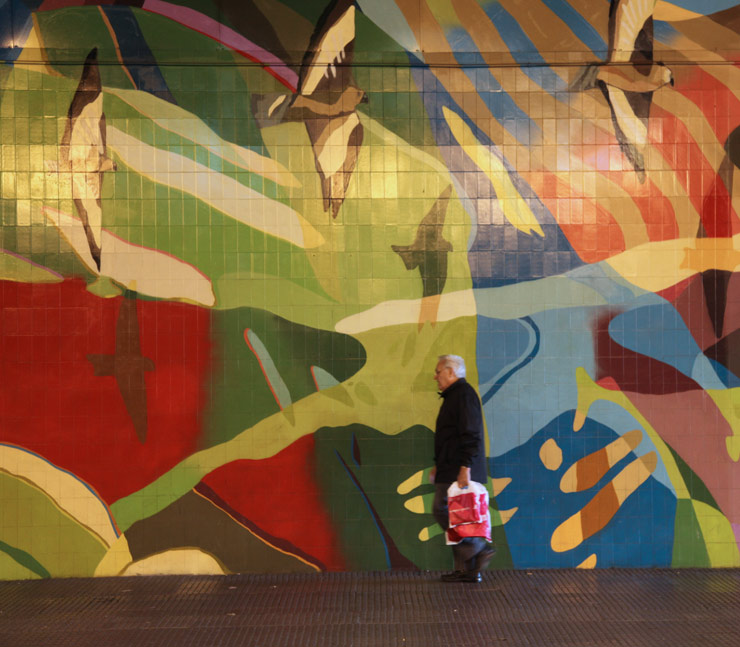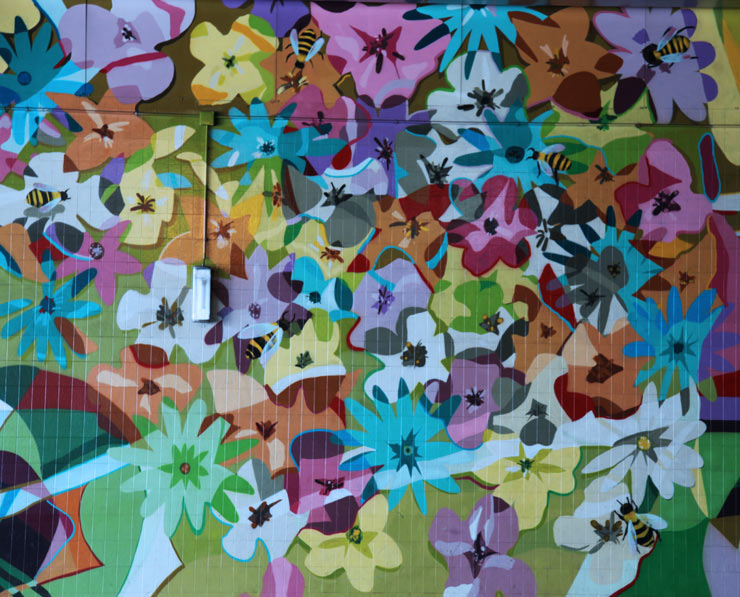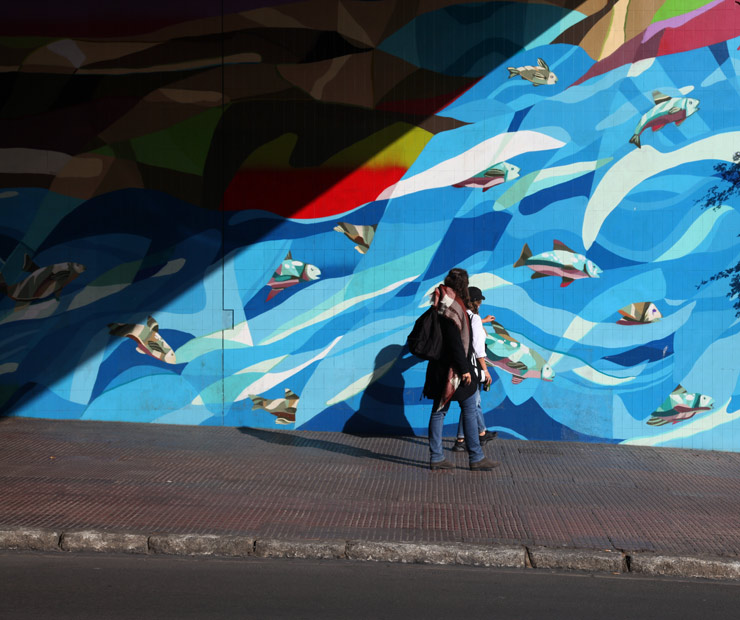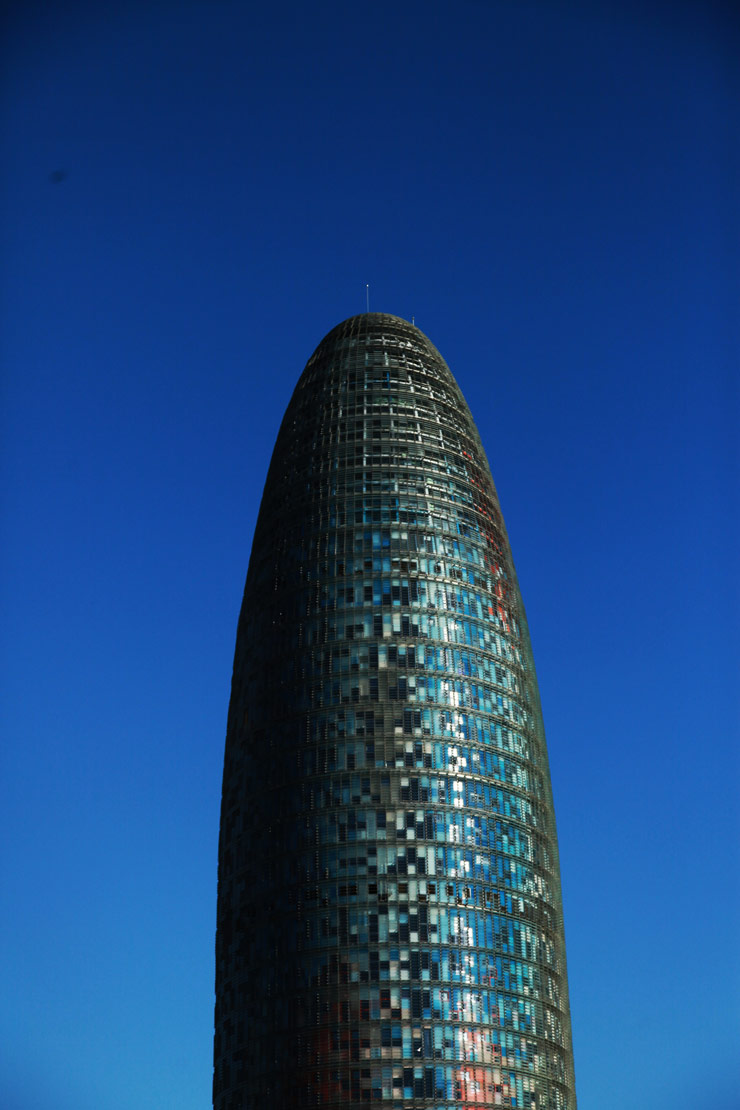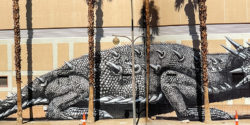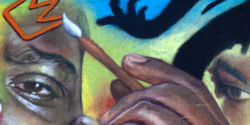
This week BSA is in Mexico City in collaboration with Urban Nation Museum of Urban Contemporary Art (UN) to see what is steering the scene on the street, meet artists, visit artist compounds, museums, galleries, and studios – and of course to capture the wild and dynamic Street Art and graffiti scene here. Where Mexico City goes in art and culture makes big waves elsewhere in Latin America, and its Street Art scene has been quickly evolving in the last decade. Join us as we investigate the character and players in this modern/traditional city of more than 21 million people.
In a cacophonous neighborhood in downtown Mexico City that sells musical instruments and equipment the second floor verandas are emitting an aerosol fragrance, a cloud of lime green to mix in the air. Some how it mixes well with the honking cars and roaring live rock and roll concert across the street in a musical equipment store where they are performing covers of 80s metal bands like Mötley Crüe and Judas Priest.
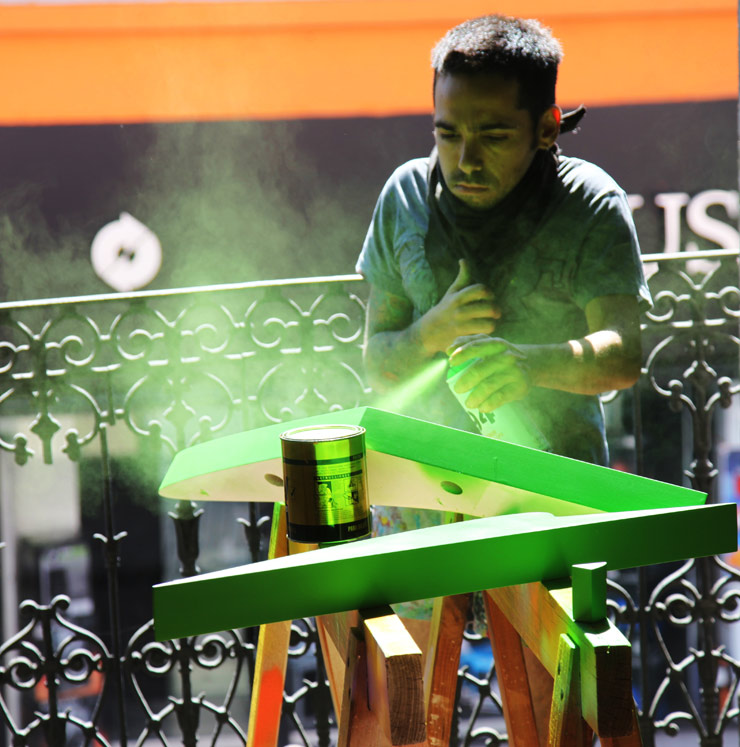
Elian. Process shot. (photo © Jaime Rojo)
Elian is balancing his new pieces on saw horses and fumigating them with bright paints which he normally might be covering a huge mural wall with.
“I’m trying to break with my tradition of being a painter do you know,” he says, one of three close friends on the Street Art scene from Argentina here in this studio.

Elian. Process shot. (photo © Jaime Rojo)
Each of the artists say they are taking a little break from the work they normally do to experiment for their upcoming show at Toba Gallery here at the beginning of December.
The year-old gallery is owned by a local Street Art celebrity named Smithe, who still pursues his own art career while choosing artists from his peers to show at this location in el Centro de la ciudad.
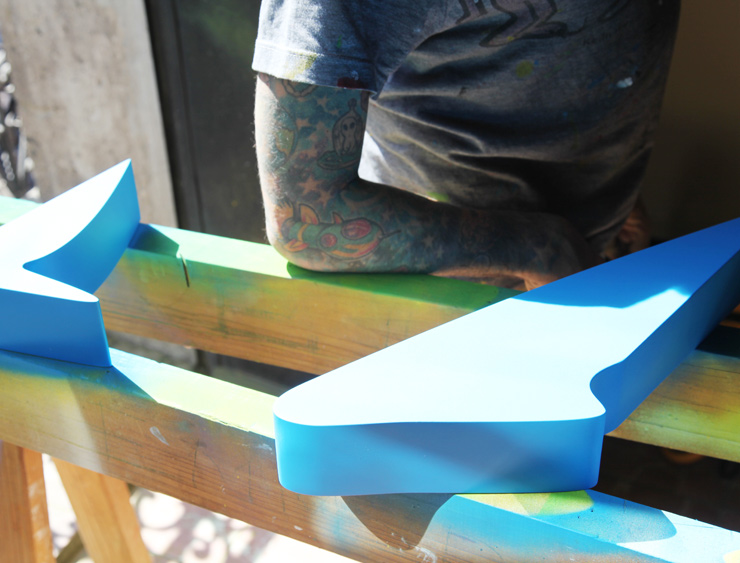
Elian. Process shot. (photo © Jaime Rojo)
“I want to build these kinds of objects and to create a dialogue with the space by changing the focus of attention by placing them around the gallery,” Elian says, pointing to imaginary spots in the air above and punctuating with his pointed index finger.
“Sort of like tick-tick-tick, like acupuncture needles, and I will mount all these pieces try to mix with the pieces of the guys.”
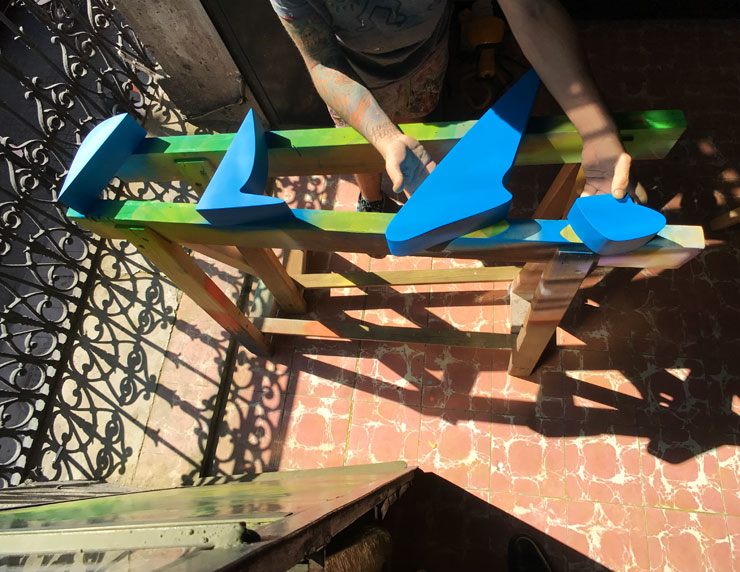
Elian. Process shot. (photo © Jaime Rojo)
The guys are Franco “JAZ” Fasoli and Nicolas “EVER” Romero, who each have their own small room in this artists’ studio enclave that is sort of hidden, requiring you to look carefully for an entrance hall behind a lottery ticket vendors signage on the street.
All three have often travelled and work together with a fourth Argentinian named Pastel in festivals and exhibitions over the past half decade, and these three consider this a happy reunion to work again with one another.
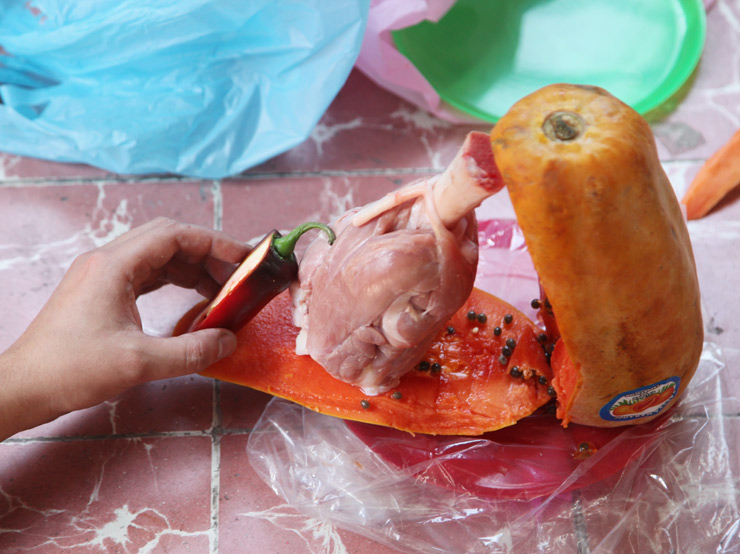
Ever. Process shot. (photo © Jaime Rojo)
Nicolas “EVER” Romero is next door sitting cross-legged on the floor trying to balance a chunk of raw meat inside a papaya, accented by a jalepeno pepper. Around him are various tropical fruits and everyday vegetables teetering upon each other and bottles of sugary sodas.
He says his newest still-lifes are mixing traditional subject matter with pieces of modern life to draw attention to the contrasts and as a critique of the commercialized consumer culture that is eroding our connection with history.
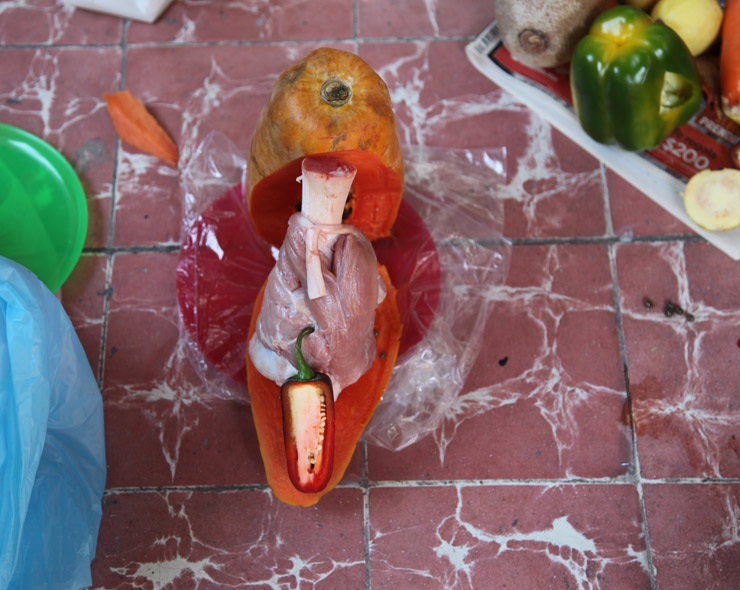
Ever. Process shot. (photo © Jaime Rojo)
“I feel like Mexico has the combination of ancient roots like the Mayan and Incan culture,” he says, “and their culture of cultivation of fruits and vegetables edit is in huge contrast with the modern world.” He blames a lot of the commercial junk food that has come into the country on the neighbor to the north, the United States.
“You can go to this store chain called Oxxo, like the 7-Eleven of Mexico, and you can see what the Mexican People are being offered to eat,” he explains.
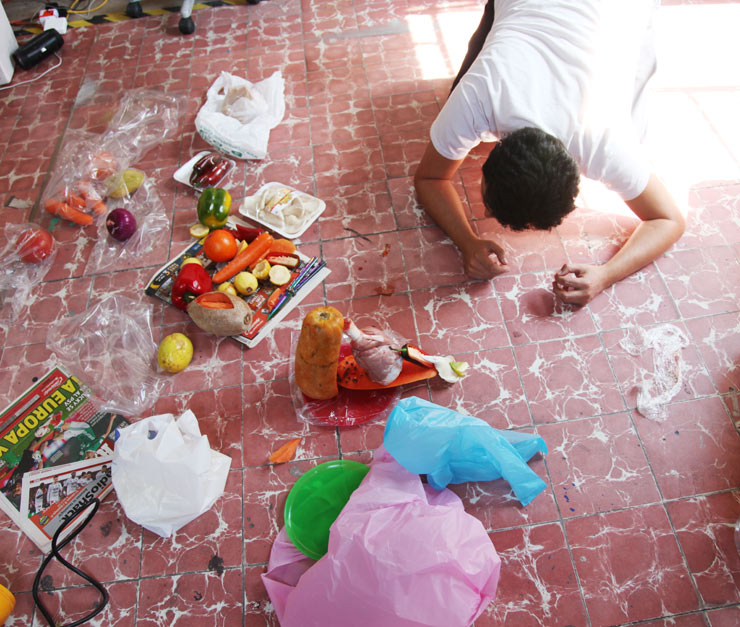
Ever. Process shot. (photo © Jaime Rojo)
“Basically they have tacos and tortillas and basically shitty food like Lays or Bimbo – super unhealthy foods.”
“That, for me, is a metaphor for Mexico. This super amazing strong food history and then you have this stuff – for me working with these real foods is part of the description for what is happening in Mexico today.”
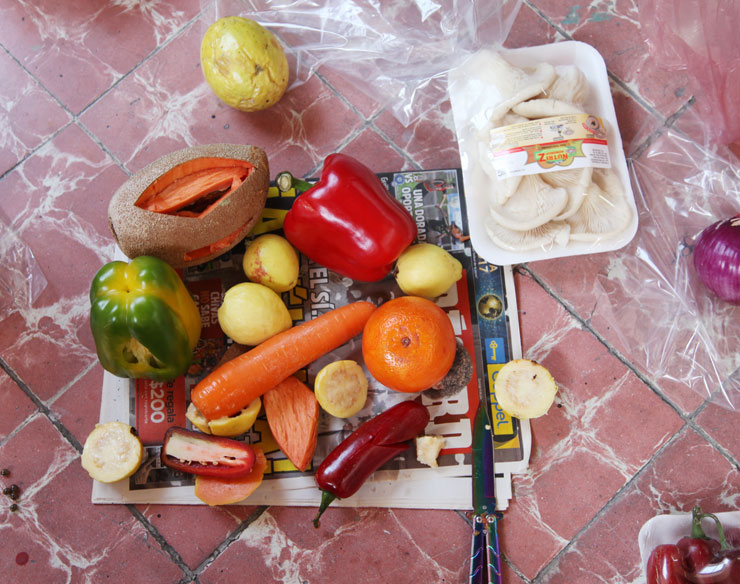
Ever. Process shot. (photo © Jaime Rojo)
The still-lifes are a departure for EVER from his figurative work as well, and he is enjoying concentrating on craft in this way.
Free from the large walls and magic surrealism of his street murals, he says he can also hide his identity in this kind of painting that is a respected practiced thought to help artists “warm” their hands.
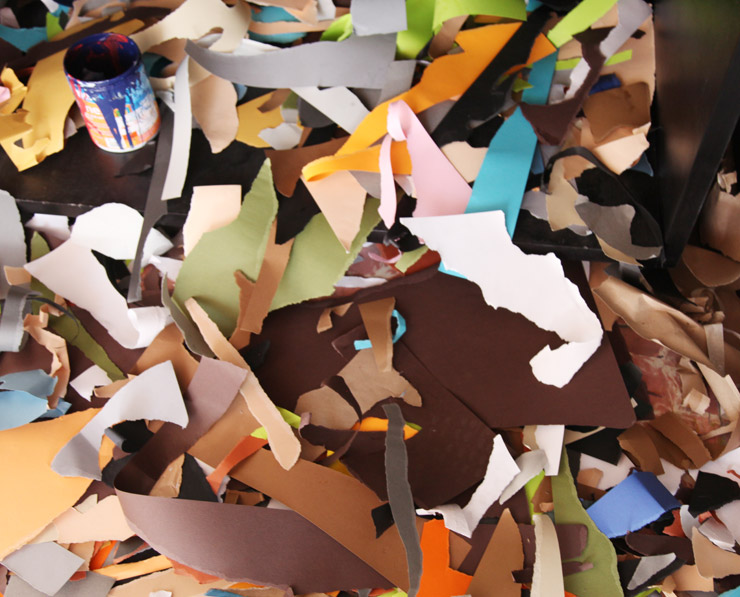
Jaz. Process shot. (photo © Jaime Rojo)
Another figurative painter known for his muscular strong characters and people, JAZ is taking a few steps back from realism to abstract. His studio features a large pile of ripped papers that he is gluing onto a sketch on brown paper.
The sketch comes from a digital collage on his laptop. He says he needed to separate himself from direct painting by creating a multi-step process like this. “I am kind of forcing myself into more abstract in a very artificial way because if I try to do it by myself.”
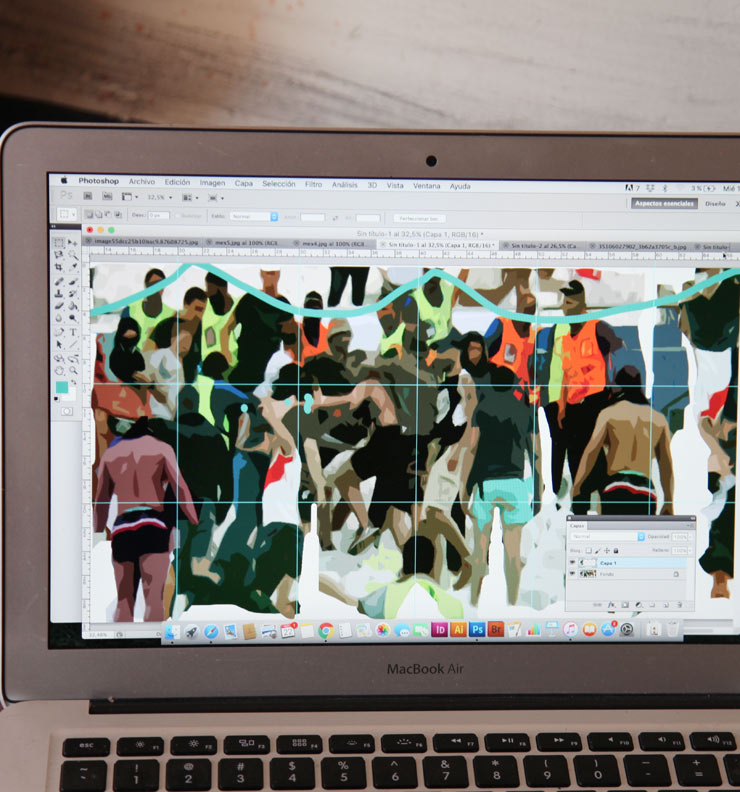
Jaz. Sketch shot. (photo © Jaime Rojo)
The 10 meter long fragile piece will hang from wires in the gallery and it reminds you that he was a sceneographer before he was know for graffiti or Street Art.
The finished rolls feature figures running with backs to the viewer in a jumbled, violent chaos of hooligans in the street. Strung overhead across the ceiling is a colorful fiesta decor, denoting a sarcastic overlay to the lawlessness. It’s contrast he enjoys.
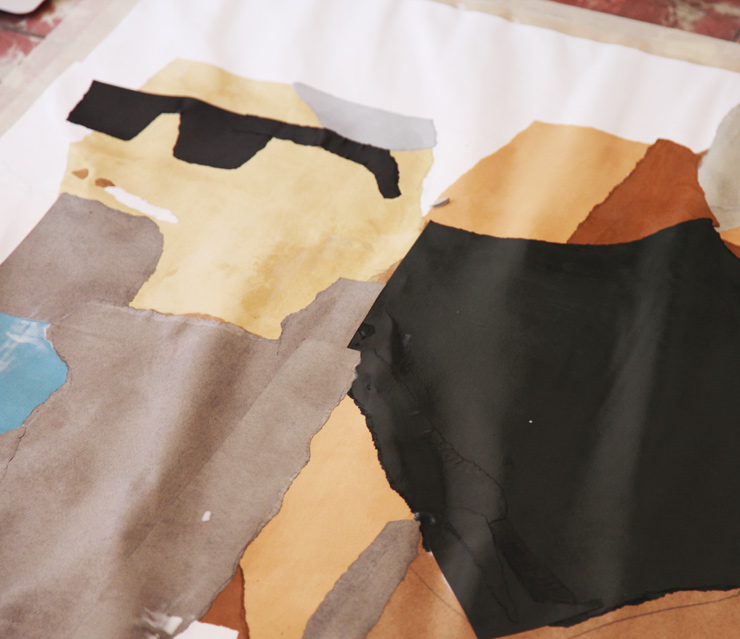
Jaz. Process shot. (photo © Jaime Rojo)
“This is a typical hooliganism that happens in South America but I also mixed up with this idea of a party or a celebration so I’m going to have these decorative streamers papers hanging from above,” he says. “It may be difficult to understand because it looks like it’s a party but at the same time there’s this clashing and it is in a sort of carnival environment in a formal way – it’s more of scene in a cinematic way.”
Having lived in Europe for the last couple of years, JAZ talks about his home town of Buenos Aires and his new ability to have perspective on some corrupt behavior and social structures that he has been examining.
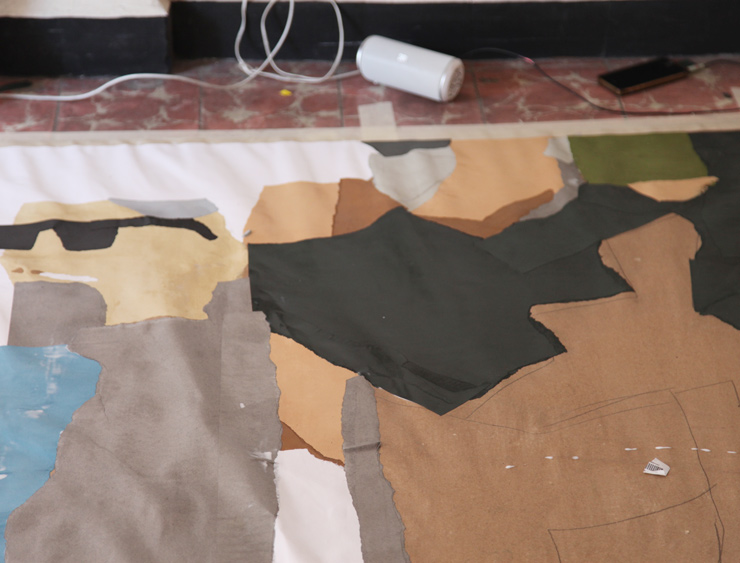
Jaz. Process shot. (photo © Jaime Rojo)
“Argentinian hooliganism is also a very strong political force,” he says. “It is not just about the activities related to the sport, it’s the mafia. It is 100% connected with politicians and drugs and crime all under one roof or protection of the sport.”
“It is a very social tool used for manipulation… extortion. It is very integrated into our society you can talk with any of us three Argentinians and talk about how deep inside our society it is. I do a kind of x-ray of how the society works by looking into just that particular segment of society.”
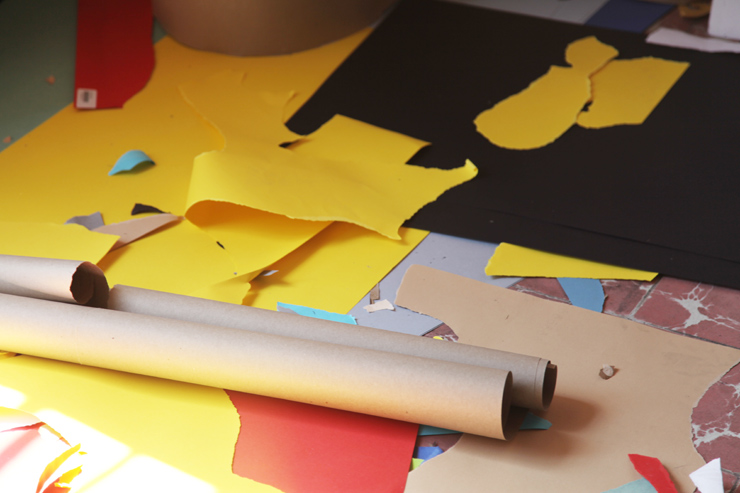
Jaz. Process shot. (photo © Jaime Rojo)
With Mexico City considered as a doorway to the Americas, it is interesting to note that these three Street Artists all express a certain admiration and solidarity with Mexico and are very familiar with the cultural traditions, heros and artifacts of the history and society; a pronounced departure from the neighbor to the north.
It is good to see again the maturation and evolution of these thirty-something artists as they dare themselves to try new techniques in pursuit of an art practice apart Street Art, and to witness the network of support that they create for each other regardless of their stylistic differences.
PROCESS: Elian, Jaz and Ever in Mexico City

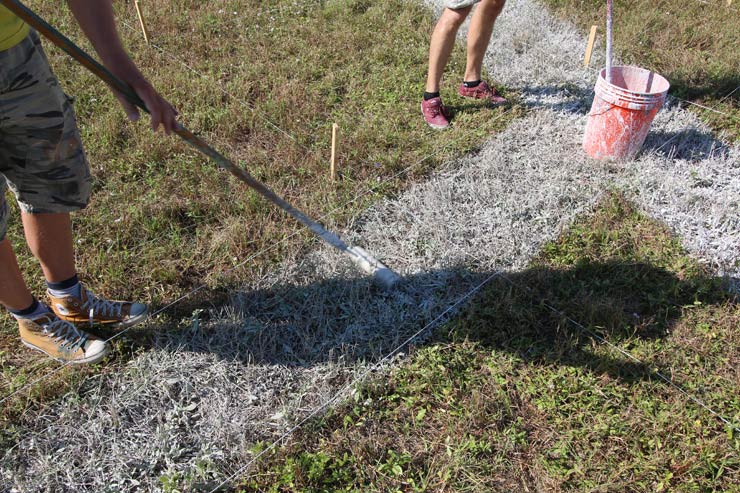
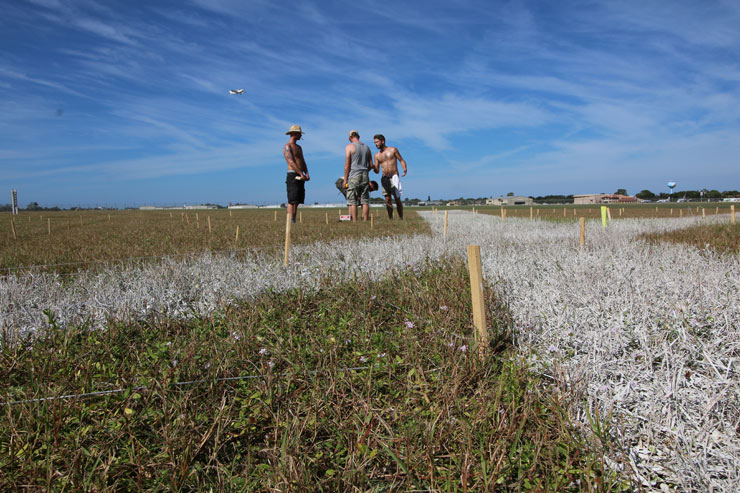
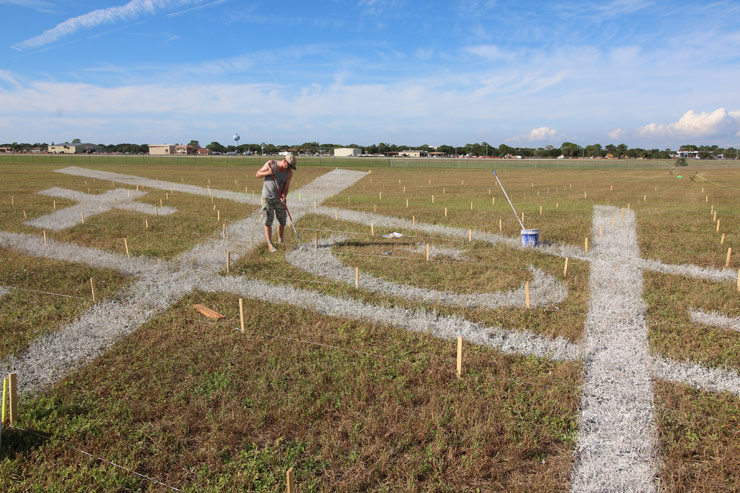


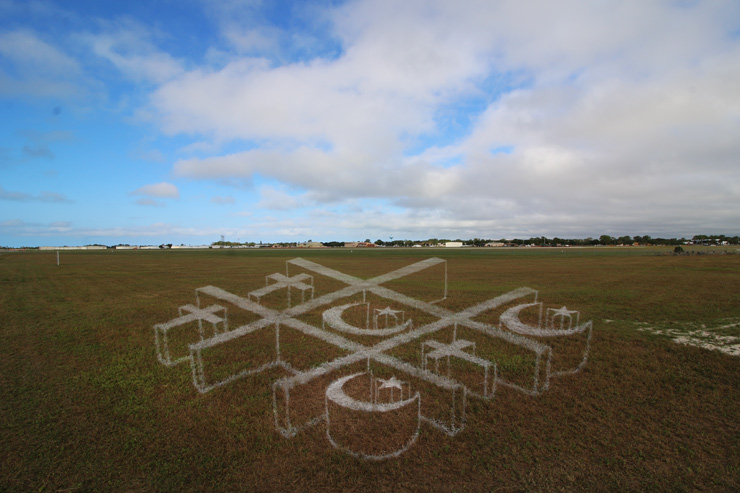
 BROOKLYN STREET ART LOVES YOU MORE EVERY DAY
BROOKLYN STREET ART LOVES YOU MORE EVERY DAY
